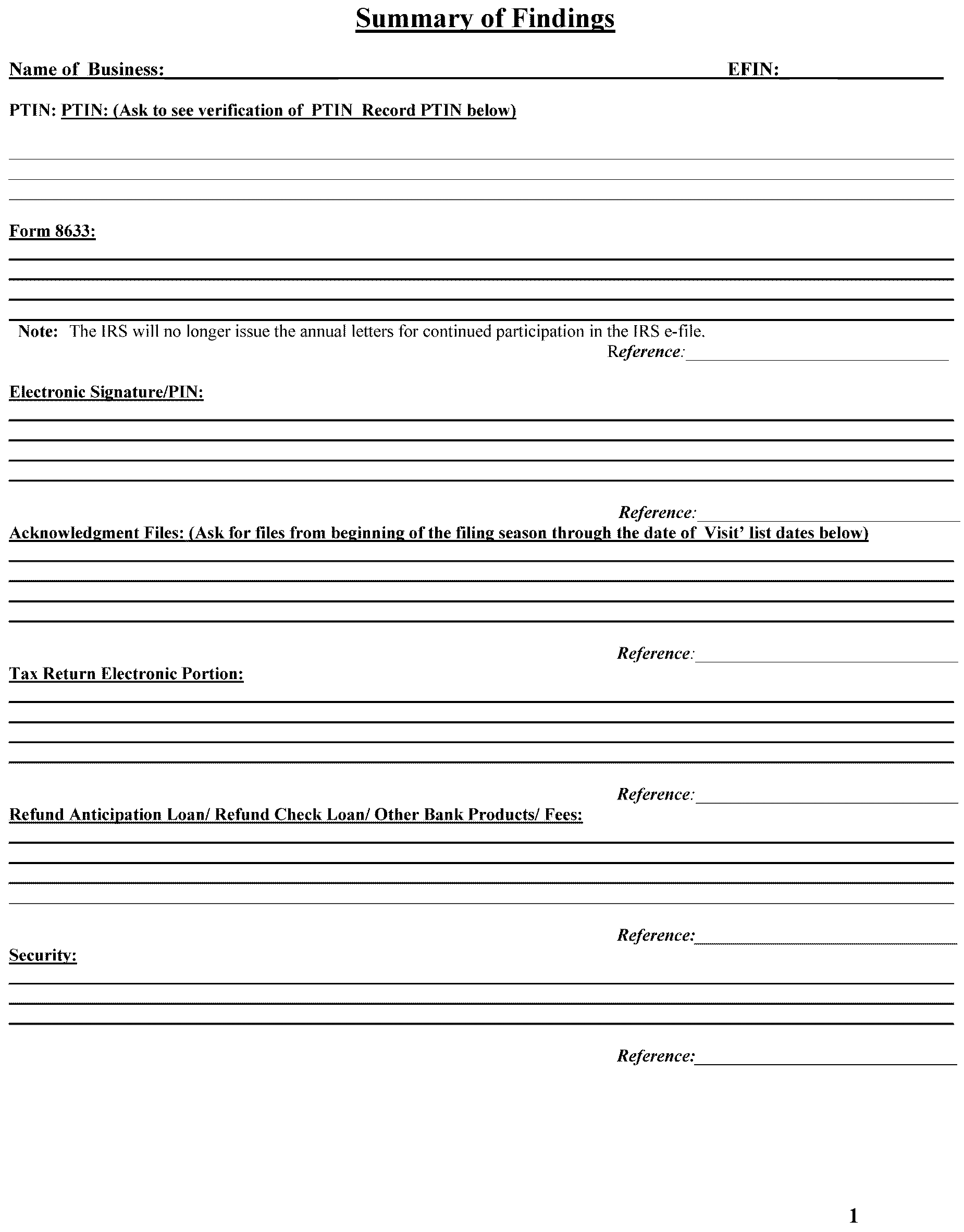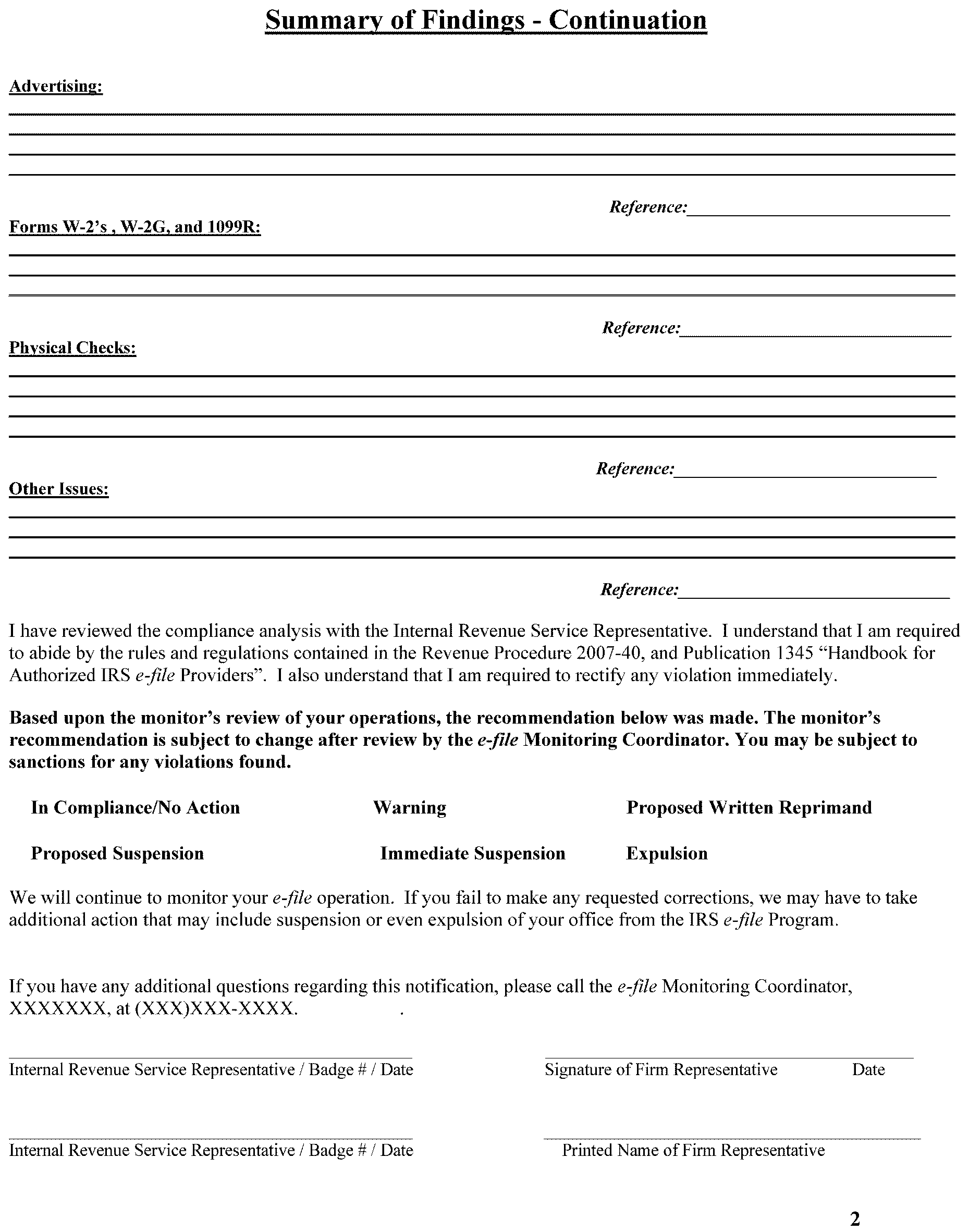- 4.21.1 Monitoring the IRS e-file Program
- 4.21.1.1 Program Scope and Objectives
- 4.21.1.1.1 Background
- 4.21.1.1.2 Authority
- 4.21.1.1.3 Roles and Responsibilities
- 4.21.1.1.4 Program Management and Review
- 4.21.1.1.5 Program Controls
- 4.21.1.1.6 Terms and Acronyms
- 4.21.1.1.7 Related Resources
- 4.21.1.2 Introduction
- 4.21.1.3 General
- 4.21.1.4 IRS e-file Provider Options
- 4.21.1.5 Referrals
- 4.21.1.6 Monitoring Visits
- 4.21.1.7 Preplan
- 4.21.1.8 Priority of Visits
- 4.21.1.9 Risk-Based Selection Criteria
- 4.21.1.10 Types of Visits and Workload
- 4.21.1.11 Referral Visits
- 4.21.1.12 Follow-up Visits
- 4.21.1.13 Targeted Visits
- 4.21.1.14 Random Visits
- 4.21.1.15 Contacting the Provider
- 4.21.1.16 Interview
- 4.21.1.17 Provider Visitations
- 4.21.1.18 Advertising
- 4.21.1.19 General Monitoring Visitation Information
- 4.21.1.20 Monitoring Techniques
- 4.21.1.21 Summary of Findings
- 4.21.1.22 Referrals
- 4.21.1.22.1 Types of Referrals
- 4.21.1.23 Infractions
- 4.21.1.23.1 Written Reprimand (Level One)
- 4.21.1.23.2 Reasonable Cause
- 4.21.1.23.3 Suspension Terms
- 4.21.1.24 Proposed Suspension (Level Two Infraction)
- 4.21.1.25 Suspension/Expulsion (Level Three Infraction)
- 4.21.1.26 Level of Infractions
- 4.21.1.26.1 Level One – Written Reprimand
- 4.21.1.26.2 Written Reprimand Process (Level One)
- 4.21.1.26.3 Level Two – One Year Suspension
- 4.21.1.26.4 Proposed Suspension Process (Level Two)
- 4.21.1.26.5 Level Two Infraction Letters
- 4.21.1.26.6 Level Three – Suspension or Expulsion
- 4.21.1.26.7 Immediate Suspension Process (Level Three)
- 4.21.1.27 Appeals Process
- 4.21.1.28 Formal Appeal
- 4.21.1.28.1 Tracking of Appeals Cases
- 4.21.1.28.2 Case File Assembly
- 4.21.1.28.3 Case Closure
- 4.21.1.29 Master Log of Cases
- 4.21.1.30 Master Log of Requests for Electronic Filing Identification Number (EFIN) Suspensions
- 4.21.1.31 EMC's Responsibilities
- 4.21.1.31.1 Soliciting and Training Monitors
- 4.21.1.31.2 Referral Visits
- 4.21.1.31.3 Follow-up Visits
- 4.21.1.31.4 Targeted Visits
- 4.21.1.31.5 Random Visits
- 4.21.1.31.6 Case Building
- 4.21.1.31.7 Control System
- 4.21.1.31.8 Managerial Reports
- 4.21.1.32 Employee User Portal (EUP)
- 4.21.1.33 Visits to Volunteer Income Tax Assistance (VITA) and Tax Counselors for the Elderly (TCE) Locations
- Exhibit 4.21.1-1 Monitoring Visit - Non Compliance Diagram
- Exhibit 4.21.1-2 Sample Letter - Warning
- Exhibit 4.21.1-3 Sample Letter - W-2 Pay Stub Warning Letter
- Exhibit 4.21.1-4 Sample Letter - Written Reprimand
- Exhibit 4.21.1-5 Sample Letter - Proposed Suspension
- Exhibit 4.21.1-6 Sample Letter - Suspension
- Exhibit 4.21.1-7 Samples of Appeals' Letters
- Exhibit 4.21.1-8 E-file Monitoring Visit Check Sheet
- Exhibit 4.21.1-9 File Sample Reviewed
- Exhibit 4.21.1-10 Summary of Findings
- Exhibit 4.21.1-11 E-file Monitoring Sanction Request
- Exhibit 4.21.1-12 Time and Action Report
- Exhibit 4.21.1-13 E-file Monitoring Coordinator's (EMC's) Master Log of Cases
- Exhibit 4.21.1-14 EMC's Control Log for Suspensions Sent to IRS e-help Campus
- Exhibit 4.21.1-15 IRS e-File Monitoring Referral and Follow Up
- Exhibit 4.21.1-16 Administrative Review Reversing a Sanction Letter
- Exhibit 4.21.1-17 E-File Monitoring Report and Instructions
- Exhibit 4.21.1-18 E-file Monitoring Appointment Letter
- Exhibit 4.21.1-19 Manager Check List for E-file Cases
- Exhibit 4.21.1-20 Recommended Suspension after Administrative Review Letter
- 4.21.1.1 Program Scope and Objectives
Part 4. Examining Process
Chapter 21. Electronic Filing Program
Section 1. Monitoring the IRS e-file Program
4.21.1 Monitoring the IRS e-file Program
Manual Transmittal
August 20, 2025
Purpose
(1) This transmits revised IRM 4.21.1, Electronic Filing Program, Monitoring the IRS E-file Program.
Background
This section updates existing procedures for monitoring Authorized IRS e-file Providers per Rev. Proc. 2007–40, Pub 3112, IRS e-file Application and Participation, and Pub 1345, Handbook for Authorized IRS e-file Providers of Individual Income Tax Returns.
Material Changes
(1) Added new IRM Internal Control components
(2) Updated Wage and Investment (W&I) to new organizational title, Taxpayer Services (TS) throughout
(3) Minor editorial changes have been made throughout this IRM. Website addresses, legal references, and IRM references were reviewed and updated as necessary.
Effect on Other Documents
IRM 4.21.1 dated August 12, 2011 is superseded.Audience
Small Business/Self-Employed (SB/SE) and Large Business and International (LB&I) examiners; Taxpayer Services (TS) Field Assistance employees; Campus Compliance Services examiners and other operating division employees that work with the electronic filing.Effective Date
(08-20-2025)
Heather J. Yocum
Director, Examination Field and Campus Policy
CTCO:S:E:HQ:EFCP
Small Business/Self-Employed
-
Purpose: This IRM section serves as a reference guide for IRS e-file monitoring procedures for examiners and e-file monitoring coordinators (EMC)
-
Audience: These procedures apply to SB/SE examiners; Taxpayer Services Field Assistance employees; Campus Compliance Services and other operating division employees that work with electronic filing.
-
Policy Owner: The Director, Examination Field and Campus Policy, under the Director, Examination Headquarters.
-
Program Owner: Field Examination Special Processes, under the Director, Examination Field and Campus Policy
-
Primary Stakeholders: SB/SE examiners, e-file monitoring coordinators and their managers
-
Contact Information: To recommend changes or make any other suggestions related to this IRM section, see IRM 1.11.6.6, Providing Feedback About an IRM Section - Outside of Clearance
-
The Electronic File Monitoring Program is an agency-wide effort to monitor and enforce Authorized IRS e-file Provider compliance with Rev. Proc. 2007-40. Authorized IRS e-file Providers are a critical component of tax administration; monitoring provides a unique opportunity to impact their behavior and overall compliance with tax laws.
-
This IRM will focus on procedures for monitoring the IRS e-file Provider role of Electronic Return Originator (ERO).
-
Authority to administer the Electronic File Monitoring Program includes, but is not limited to, the following:
-
Rev. Proc. 2007-40
-
Pub 3112, IRS e-file Application & Participation
-
Pub 1345, Handbook for Authorized IRS e-file Providers of Individual Income Tax Returns
-
-
It is the responsibility of the Authorized IRS e-file Provider to ensure they comply with the latest version of all publications and notices.
-
The Director, Examination Headquarters, is the executive responsible for providing policy and guidance for Field employees and ensuring consistent application of policy, procedures and tax law to effect tax administration while protecting taxpayers’ rights. See IRM 1.1.16.5.5, Examination Headquarters, for additional information.
-
The Director, Examination Field and Campus Policy, reports to the Director, Examination Headquarters, and is responsible for the delivery of policy and guidance that impacts the Field Examination process. See IRM 1.1.16.5.5.1, Examination Field and Campus Policy, for additional information.
-
Field Examination Special Processes (FESP), under the Director, Examination Field and Campus Policy, is the group responsible for providing oversight and policy and procedural guidance on specialized examination processes to SB/SE Field examiners and group managers. See IRM 1.1.16.5.5.1.2, Field Examination Special Processes.
-
Program Reports. Periodic program reviews are conducted by FESP to:
-
Assess the effectiveness of specific programs within Examination or across the organization,
-
Evaluate adherence to procedures to identify opportunities for policy improvements, and
-
Validate policies and procedures, and
-
-
This program is tracked through HQ provided control logs such as EMC’s Master Log of Cases, EMC’s Control log for Suspensions Sent to IRS e-help Campus, and E-File Monitoring Report
-
Monitor’s group manager review the case file and are asked to use the Manager Check List for e-file Cases to assist with the review.
-
The following table contains a list of terms used throughout this IRM and their definitions.
Term Definition Authorized IRS e-file Provider (Provider) A firm accepted to participate in IRS e-file. Deconfliction The process of reviewing cases selected for e-file monitoring to see if other IRS enforcement activities may already be underway on the Provider, Principals, Responsible Officials or Firm and to determine if e-file monitoring will continue at the same time as other enforcement activity. The deconfliction process is designed to save resources by sharing information and to reduce taxpayer burden. Electronic Return Originator (ERO) An Authorized IRS e-file Provider that originates the electronic submission of returns to the IRS. Filing Season The time period, generally between January 1 and April 15 of each year, when individual taxpayers traditionally submit their tax returns to report activity from the prior year. IRS e-file The brand name of the electronic filing method established by the IRS. Levels of Infractions Categories of infractions of IRS e-file rules based on the egregiousness of the infraction with specified sanctions associated with each level. -
Level One is the least egregious,
-
Level Two is moderately egregious and,
-
Level Three is the most egregious.
Principal Generally, the Principal for a business or organization includes: -
Sole Proprietors.
-
Each partner who has a 5 percent or larger interest in a partnership.
-
All officers of a corporation.
-
An individual authorized to act for the entity in legal and/or tax matters for an entity that is not a sole proprietorship, partnership, or corporation.
Responsible Official An individual with authority over the IRS e-file operation of the offices of an Authorized IRS e-file Provider, who is the first point of contact with the IRS and has authority to sign revised IRS e-file applications.
A Responsible Official is responsible for ensuring the Authorized IRS e-file Provider adheres to the provisions of Rev. Proc. 2007-40, Pub 3112 and Pub 1345 and other publications and notices governing IRS e-file.Sanction An action taken by the IRS to suspend or expel an Authorized IRS e-file Provider from participation in IRS e-file, based on the level of infraction. (See above: Levels of Infraction.) Stockpiling Waiting more than three calendar days to submit returns to the IRS after the Provider has all necessary information for origination of the electronic return or collecting e-file returns prior to official acceptance for participation in IRS e-file. Suitability A check conducted on all firms and the Principals and Responsible Officials of firms when an IRS e-file application is initially processed, and on a regular basis thereafter. The suitability check consists of a tax compliance check and includes a background check conducted by the IRS to ensure the firm and individuals are eligible for participation in IRS e-file. -
-
The following table lists acronyms used throughout this IRM and their definitions.
Acronym Definition CI Criminal Investigation EFIN Electronic Filing Identification Number EIN Employer Identification Number EMC E-File Monitoring Coordinator ERO Electronic Return Originator ETIN Electronic Transmitter Identification Number EUP Employee User Portal IDRS Integrated Data Retrieval System PSP Planning and Special Programs PTIN Preparer Tax Identification Number RAL Refund Anticipation Loan RPP Return Preparer Program SB/SE Small Business/Self-Employed SSN Social Security Number
-
The following table list related resources which contain additional guidance examiners may reference regarding the Electronic File Monitoring Program:
Resource Title Rev. Proc. 2007–40 n/a IRM 3.42.10 Authorized IRS e-file Providers IRM 4.11.55 Power of Attorney Rights and Responsibilities Pub 1345 Handbook for Authorized IRS e-file Providers of Individual Income Tax Returns Pub 3112 IRS e-file Application & Participation
-
This section discusses monitoring of Authorized IRS e-file Providers.
-
Monitoring of authorized IRS e-file providers is conducted by IRS e-help and Small Business/Self-Employed (SB/SE) Examination to ensure compliance with Rev. Proc. 2007–40, IRB 2007-26 1488, Pub 3112, IRS e-file Application and Participation, and Pub 1345, Handbook for Authorized IRS e-file Providers of Individual Income Tax Returns, that govern IRS e-file.
-
Noncompliance issues discovered outside of IRS e-file should not be addressed during the e-file monitoring visit. However, prior to closing the case, the e-file monitoring coordinator (EMC) must document and retain in the case file the reason a referral is warranted and timely complete a referral to the appropriate function:
-
Area Return Preparer Coordinators (RPC) for a Program Action Case (PAC)
-
Criminal Investigation (CI)
-
Area Earned Income Tax Credit (EITC) Coordinators
-
-
All referrals to the RPC, CI, or the EITC coordinator must be reported timely to SB/SE Examination Headquarters e-file Exam Policy program analyst (herein after referenced as Exam HQ e-file analyst) via the "E-file Compliance Monitoring Report." See Exhibit 4.21.1-17.
-
IRS e-help is responsible for processing and accepting e-file applications from all applicants to participate in IRS e-file. In addition, IRS e-help performs suitability checks on all applicants and providers to ensure the provider meets the requirements to participate in IRS e-file. IRS e-help also monitors the testing of a transmitter’s software and documents and the quality of the transmission of the e-file returns. They will contact the provider directly to correct problems identified in the transmission of returns.
-
The area office EMC is responsible for all field aspects of monitoring providers. Monitoring is generally accomplished through visits to the provider’s establishments either by the EMC and/or e-file Monitor(s) trained by the EMC. The monitor(s) or the EMC monitors the operation of a provider and advises providers of violations identified at the locations.
-
Violation(s) may result in a warning, a written reprimand, suspension or expulsion from participation in IRS e-file, depending on the severity of the infraction. Referral and follow-up visits are used to investigate allegations, complaints, and warnings against Authorized IRS e-file Providers. Referrals and follow-ups visits may be mandatory visits depending on the severity of the issue and the facts determined. The decision is made by the EMC after reviewing the information. Random and targeted visits are used to determine general compliance within IRS e-file. See IRM 4.21.1.10, Types of Visits and Workload, for a description of each type.
-
To sanction a provider as a result of monitoring, the EMC faxes a completed e-fileMonitoring Sanction Request, Exhibit 4.21.1-11, to IRS e-help with a copy of the signed sanction letter. See Exhibit 4.21.1-6, Sample Letter - Suspension, that was mailed to the provider. IRS e-help staff will update the Third Party Data Store (TPDS) appropriately to place the provider in non-compliance (field meeting) status.
-
For definitions of Electronic Return Originator (ERO), Intermediate Service Provider, Software Developer, Transmitter, and Reporting Agent, see Rev. Proc. 2007–40, section 3.
-
Participants in IRS e-file are referred to as Authorized IRS e-file Providers (providers). They offer clients a special service which produces higher quality returns. Benefits include an IRS acknowledgement of receipt of the electronic return. This acknowledgement does not occur with paper returns. Electronic returns also go through validation and are rejected for certain kinds of inaccuracies. The accuracy rate of e-file returns is greater than that of paper returns.
-
Applicants select the provider options that are best for them. They may select one option, or a combination of the following provider options:
-
Electronic Return Originator
-
Intermediate Service Provider
-
Transmitter
-
Software Developer
-
Online Provider
-
-
Electronic Return Originator (ERO) - An ERO originates the electronic submission of a tax return through IRS e-file after the taxpayer authorizes the electronic filing of the return.
-
Intermediate Service Provider (ISP) - An ISP receives tax returns from EROs (or from a taxpayer or tax exempt organization that files electronically using a personal computer, modem or the Internet, and commercial tax preparation software), processes the return information, and either forwards the information to a transmitter, or sends the information back to the ERO (or to the taxpayer or exempt organization).
-
Transmitter - A transmitter will send the electronic return data directly to the IRS. EROs can become transmitters and transmit return data themselves, or they may contract with accepted third-party transmitters that will transmit the data for them. A transmitter must have software and computers that allow it to interface with the IRS.
-
Software Developer - A software developer develops software for the following purposes:
-
Formatting electronic return information according to publications issued by the IRS that set forth electronic return file specifications and record layouts for tax returns; and /or
-
Transmitting electronic tax return information directly to the IRS.
-
-
Online Filing Provider - An online filing provider allows taxpayers to self-prepare returns by entering return data directly into commercially available software, software downloaded from an Internet site and prepared off-line, or through an online Internet site.
-
The categories used to describe providers are not mutually exclusive. For example, an ERO can simultaneously be a transmitter, a software developer, or an ISP depending on the function being performed.
-
EMCs will receive external referrals by telephone from other providers, tax professionals, and taxpayers as call assistors provide the name and telephone number of the appropriate area EMC to callers wanting to report potential violation of e-file rules.
-
EMCs will receive internal referrals from IRS employees who believe a provider is violating IRS e-file rules. The referring employee will do the following:
-
Prepare the top portion of Exhibit 4.21.1-15, IRS e-file Monitoring Referral and Follow Up Template;
-
E-mail the completed referral template to the EMC for the state/area of the ERO's location;
-
Include the name of the EMC in IRS e-help comments; and
-
Access the following link to obtain the name and e-mail address of the local Area EMC
-
-
Monitoring visits include the following stages:
-
Preplanning
-
Contacting the provider
-
Interviewing the provider (principal, primary contact, alternate contact, or responsible official, or contact representative identified on Form 8633, Application to Participate in IRS e-file Program)
-
Reviewing records and files
-
Issuing summary of findings
-
Issuing a written warning letter or preparing a written reprimand letter, if applicable.
-
-
Monitors should receive case files via Form 3210, Document Transmittal, from the EMC. These cases will not be established on the Audit Information Management System (AIMS). They must be established on Examination Returns Control System (ERCS) or controlled manually by the EMC. Monitors should review the case file and ensure the following information is included:
-
Identification of type of case – referral, follow-up, targeted, or random;
-
EUP Application Information;
-
Exhibit 4.21.1-8, E-file Monitoring Visit Check Sheet;
-
Exhibit 4.21.1-12, Time and Action Report;
-
Exhibit 4.21.1-10, Summary of Findings, and Exhibit 4.21.1-11, E-file Monitoring Sanction Request;
-
Historical Information - referrals or complaints, prior provider visits, correspondence, suitability letters, etc., if available;
-
Form 9984, Examining Officer's Activity Record; and
-
Integrated Data Retrieval System (IDRS) information.
-
-
Visits should be scheduled in the following order:
-
Referrals (mandatory for each valid complaint received)
-
Follow-up (mandatory if follow-up from prior year's issuance of warning or reprimand letter)
-
Targeted
-
Random (random visits should be identified to meet area e-file monitoring visit program goals only when all other sources have been exhausted, e.g. referral, follow-up, targeted)
-
-
For targeted monitoring visits, the established risk-based selection criteria includes providers ≡ ≡ ≡ ≡ ≡ ≡ ≡ ≡ ≡ ≡ ≡ ≡ ≡ ≡ ≡ ≡ ≡ ≡ ≡ ≡ ≡ ≡ ≡ ≡ ≡ ≡ ≡ ≡ ≡ ≡ ≡ ≡ ≡ ≡ ≡ ≡ ≡ ≡ ≡ ≡ ≡ ≡ ≡ ≡ ≡ ≡ ≡ ≡ ≡ ≡
-
In addition, all providers issued written warnings or written reprimands are subject to follow up monitoring visits in the subsequent tax return filing season to ensure corrective actions have been taken.
-
Documentation is required to support referrals from internal and external sources, including the receipt and dispositions of referrals and the actions taken based on these referrals.
-
The number of provider monitoring visits for an area is determined based on the total number of providers within a given geographical area. The Exam HQ e-file analyst will advise the area EMCs of the number of visits their area should conduct annually. The visits will be one of the four types listed in priority order below:
-
Referral Visits: Involve the receipt of a referral from providers, return preparers, taxpayers, IRS e-help, and other IRS functions. If the referral clearly suggests non-compliance, a mandatory visit is warranted.
-
Follow-up Visits: May be mandatory and are based on violations identified in a previous year.
-
Targeted Visits: Based on selection criteria indicating that e-file compliance issues may be present. The risk-based criterion must be used when selecting providers for targeted visits. See IRM 4.21.1.9 , Risk-Based Selections Criteria, for additional information.
-
Random Visits: Determines general compliance within IRS e-file and are based upon non-discriminatory sampling of active providers. The random visits will be identified after the workload for referral, follow-up, and targeted visits have been identified.
-
-
Referrals and follow-up visits are used to investigate allegations, complaints, and warnings against providers. Referrals and follow-ups may be mandatory depending on the severity of the issue. The decision is made by the EMC after reviewing the information.
-
Targeted and random visits are used to determine general compliance with IRS e-file. Targeted and random visits are not mandatory and may be scheduled appointments. The EMC or monitor(s) will take appropriate measures to ensure compliance with IRS e-file requirements by conducting a visit and by completing the E-file Monitoring Visit Check Sheet. See Exhibit 4.21.1-8
-
All referrals must be reviewed and evaluated by the EMC upon receipt. If the referral clearly suggests noncompliance, it must be placed in priority status and becomes a mandatory visit. See IRM 4.21.1.10 for a definition of types of visits. The EMC prepares the case file and forwards it to the monitor using Form 3210, Document Transmittal, for a visit within five working days upon receipt of the case. If the monitor cannot make the visit within five working days, the area EMC must be contacted.
-
Referrals include, but are not limited to:
-
Information or complaints received from providers, other tax preparers, taxpayers, IRS e-help, and other IRS functions.
-
The EMC may acknowledge receipt of the complaint or information as appropriate. However, any actions taken may not be disclosed to external sources.
-
-
A follow-up visit originates from a previous year’s visit that involved an identified violation. If the follow-up visit is based upon a written reprimand, the EMC determines if a visit is necessary to ensure corrective action has taken place. See Exhibit 4.21.1-2, Sample Letter - Warning, or Exhibit 4.21.1-4, Sample Letter - Written Reprimand.
-
A targeted visit is based upon reject rates provided in IRM 4.21.1.9, Risk-Based Selection Criteria, due to error codes that indicate e-file compliance issues may be present in a particular provider's e-file practice. The Exam HQ e-file analyst will provide a list of e-file providers that meet this criteria to the EMC. To select targeted visits, the EMC should select e-file providers with the highest reject rates from the list provided by the Exam HQ e-file analyst for the geographic location needed.
-
A random visit is a tool used to conduct monitoring visits based upon a non-discriminatory sampling of active providers. Random monitoring visits are conducted by area offices and should be made by appointment. Random visits are determined based on a sample selected from a central database of active providers in the monitor’s geographic area. The Exam HQ e-file analyst will provide an inventory of random visits if requested. See IRM 4.21.1.10 (3).
-
Referral and Follow-up Visits - Unannounced visits are recommended. Immediately upon arrival, the monitor should advise the provider of the purpose of the visit and the approximate time needed to perform the monitoring visit. The monitor should request the necessary records to conduct the visit. Monitors should be as unobtrusive to the provider’s operation as possible.
-
Targeted and Random Visits - Targeted visits and random monitoring visits should be made by appointment. Upon receipt of the provider case file, it is recommended that the monitor contact the provider by telephone to schedule an initial appointment and advise the provider of the purpose of the visit and the approximate time needed to perform the monitoring visit. The monitor should send an e-file Monitoring Appointment Letter, Exhibit 4.21.1-18, to the e-file provider confirming the appointment and identifying the records that should be made available for review during the e-file monitoring visit. Monitors should be as unobtrusive to the provider's operations as possible.
-
All visits should be conducted in a professional and courteous manner. It is recommended that the monitor conduct the interview prior to reviewing the provider’s records. If the team approach is used, one monitor may interview the provider while the other monitor reviews the records. Interviews should only be conducted with an authorized individual identified on Form 8633, Application to Participate in IRS e-file Program, information which could include a principal, responsible official, primary contact, or alternative contact representative.
-
Monitors should use Exhibit 4.21.1-8, E-file Monitoring Visit Check Sheet, to conduct the interview with the provider.
-
The promotion of goodwill and open communication between the IRS and providers is important. Provider visitations promote goodwill and open communication between the IRS and providers. The visitations are also a means of communicating fraud awareness to providers, detecting fraud, and ensuring that providers are in full compliance with Rev. Proc. 2007–40, Pub 3112, and Pub 1345.
-
The monitor or the EMC reviews the operations of a provider, which may include its satellite offices, temporary offices, and seasonal offices and advises the provider of any violations identified at those locations. Monitoring includes, but is not limited to:
-
Reviewing IRS e-file submissions;
-
Investigating complaints;
-
Scrutinizing advertising material;
-
Visiting offices and observing office procedures;
-
Inspecting files, see Exhibit 4.21.1-9, File Sample Reviewed;
-
Confirming the signature or personal identification number (PIN) requirements for transmitting returns;
-
Confirming paid return preparer's signature (name), PTIN, and EIN of the firm (if applicable) are correctly reported on all returns transmitted;
-
Verifying compliance with the provision of IRC 6695(g) relating to the due diligence requirements for returns claiming EITC if the provider is an income tax return preparer;
-
Scrutinizing refund procedures to ensure compliance with IRC 6695(f), Negotiation of Check; and
-
Evaluating security requirements to ensure unauthorized disclosure of taxpayer information does not occur.
-
-
Violation(s) may result in a warning letter, written reprimand, suspension, or expulsion of the provider depending on the severity of the infraction, and/or penalties under IRC 6695 and/or IRC 6713.
-
Prior to any visitation, the EMC must coordinate with other functions to determine:
-
If CI has any providers under investigation, a "request for deconfliction." will be prepared by the Exam HQ e-file Analyst for all providers identified for visits at the beginning of each fiscal year program and submitted to the CI Refund Crimes Headquarters Analyst. The EMC must then deconflict these providers at the local level by submitting an e-mail request to deconflict to the local CI Return Preparer Program/Questionable Refund Program (RPP/QRP) Coordinator. For providers identified for visitations by the EMCs after the start of the program, the EMC is responsible for requesting deconfliction. The EMC will submit a deconfliction request via e-mail to the CI Refund Crimes Headquarters Analyst and the local RPP/QRP Coordinator.
-
If Examination is considering a return preparer PAC, contact the area’s PSP Return Preparer Coordinator with responsibility for PAC cases.
-
-
A team from the area office may perform the compliance monitoring visits. A team approach is preferred if resources are available. A team consists of two IRS representatives. At least one member of each team must represent Examination.
-
Team members will be trained by the EMC to perform targeted visits, random visits, mandatory visits, identify violations, to issue written warnings and prepare written reprimands, summarize findings, and make referrals. Additional training will be given to team members as rules, tax law, and procedures are amended.
-
Team assignments will be made by the EMC based upon the geographic location of the providers, staffing, and the required number of visits to be performed.
-
All monitors should advise the provider of the purpose of the visit and the approximate length of time needed immediately upon arrival. Monitors should be as unobtrusive to the provider's operations as possible. Monitors should always be professional and courteous when performing visitations.
-
The EMC should gather all available reports for supporting documentation. This includes:
-
IDRS research data or other internal compliance reports used in supplementing this effort.
-
IRS e-file application (Form 8633) information from the EUP, including the summary and any other pertinent pages.
-
-
The monitoring team should complete an E-file Monitoring Visit Check Sheet for each visitation.
-
The following are some items to consider when conducting visitations:
-
Advertising
-
Recordkeeping retention
-
Fee schedule
-
Form 8879, IRS e-file Signature Authorization
-
Form W-2s, Wage and Tax Statement
-
Return preparation
-
EITC requirements/due diligence
-
Security of taxpayer documents
-
Fraud awareness
-
Additional comments, including suggestions/feedback from the provider
-
-
A provider that does not cooperate with monitoring efforts must be advised that such action may result in immediate suspension from participating in IRS e-file. The facts regarding the provider’s failure to cooperate must be documented on the Form 9984, Examining Officer’s Activity Record, and the monitor should initiate immediate suspension procedures. See IRM 4.21.1.26.7.
-
The area office monitors must close the e-file monitoring visit case file to their group manager who will then close it to the EMC using Form 3210 according to the due dates prescribed by the area office.
-
If the monitor visits a physical location for an Authorized IRS e-file Provider and finds that the provider is no longer operating at that address:
-
The monitor will attempt to contact the provider by telephone to obtain the correct address and/or other relevant information. If the monitor is able to contact the provider, monitor should request that the provider update applicable information on Form 8633 via the Registered Users Portal (RUP) or contact IRS e-help at 866-255-0654. The monitor should then conduct a site visit at the new location.
-
If the monitor is not able to contact the provider, the monitor will contact the EMC who will research all available systems to attempt to locate a new address, or an alternate address or phone number for the provider. If a new address cannot be found, the EMC will fax an E-file Monitoring Sanction Request, Exhibit 4.21.1-11 to ANSC requesting the electronic filing identification number (EFIN) be suspended due to “Form 8633 not updated. The EMC must flag the case as "follow-up."
-
IRS e-help assistors will update the information on the comments section of the Form 8633 associated with the EFIN to show that the provider is not operating at the physical address on record per the field monitoring visit. The EFIN will be placed in "inactive" status and the Provider Option will be put in "dropped" status, using Reason Code 64 (Inactive – no response to inquiries).
-
If the provider subsequently calls IRS e-help inquiring about its EFIN being inactive, the IRS e-help assistor will update the address and other information on TPDS with information secured from the provider. Documentation will be entered into the e-case to reactivate the provider and return the EFIN to "active" status. The EMC must access EUP weekly during the filing season to determine if the provider’s address on EUP has been updated and the provider’s EFIN has been re-activated.
-
-
Competitors and taxpayers often call the EMCs or Customer Service call sites to report advertising irregularities.
-
The EMC and/or monitor reviews questionable advertising brought to their attention from internal and external referrals to ensure compliance.
-
Advertisements that the e-file monitor determines are not in compliance with the requirement of Rev. Proc. 2007–40, Pub 3112, and Pub 1345 must be brought to the attention of the provider to resolve the problem. If the provider does not take any corrective action, issue a warning letter specifically outlining the corrective action necessary to resolve the cited deviation, including a specified date for compliance. If the provider declines to take action to correct an advertisement or if the advertisement is not discontinued, pursue sanctions in accordance with the level of infractions.
-
A provider must not use "Internal Revenue Service" or "IRS" within a firm’s name, or within a firm's name for advertising purposes.
-
In situations where a provider does not comply with e-file rules, the monitor is responsible to initiate a warning, or draft the appropriate sanction letter and notify the EMC in the area where the provider has its main office. Reasons for suspensions may also be the same reasons for denials of participation, included in Pub 3112.
-
The IRS can immediately suspend, without notice, a provider from participation in IRS e-file. However, in most circumstances, a suspension from participation in IRS e-file is effective as of the date stated in the letter informing the provider of the suspension.
-
If a provider is being investigated by CI, the EMC should contact CI and discuss sanctions. If CI agrees the provider can be sanctioned, but advises the Scheme Development Center (SDC) not to initiate sanctions, the EMC can use another documented infraction to sanction the provider.
-
If the area office is notified of, or finds during a monitoring visitation, that a provider is not complying with IRS e-file rules, the area will perform the following:
-
Document the questionable practice;
-
Determine which geographical area is affected (area office only or multiple areas);
-
If more than one area is affected, determine the controlling area;
-
Provide documentation of the violations to the EMC of the controlling area; and
-
Advise the TS National Account Manager, if applicable.
-
-
The EMC of the controlling area will determine the severity of the reported violations and will schedule a monitoring visit if one has not been conducted, or issue the appropriate sanctions letter.
-
The monitor(s) may sign warning letters issued during a site visitation. In addition, a warning letter signed by the EMC must be issued to the controlling office. For the purpose of this section, a designated individual may represent the EMC.
-
The following techniques may be used by the monitoring team to identify potential violations within IRS e-file. The list is not all inclusive. The monitoring team may develop its own techniques to identify violations.
-
Tax Returns - Confirm that the provider provided a copy of the completed tax return to the taxpayer. Select a sample of tax returns for review and complete the "File Sample Reviewed" form. Based upon the analysis of the returns, monitors may identify the preparation of questionable tax returns. If this occurs, the monitor should make a referral to the RPC and identify the issues in question.
-
IRS e-file Application - To become an authorized IRS e-file provider, an applicant must complete Form 8633, Application to Participate in IRS e-file Program. Any changes to the application information must be submitted to the IRS within thirty (30) calendar days. Once approved to participate in IRS e-file, the provider will receive an "acceptance letter" containing their EFIN. Review the ERO's application information on EUP to ensure that the provider’s information is correct.
-
Ensure that the provider contacted the IRS with Form 8633 changes within thirty (30) calendar days.
-
Review Form 8633 closely to determine if the owner's structure is correct and the owners are the same. Ask the employees to identify the owner of the business and who pays them. A sole proprietor with five (5) employees or more may lead to a referral for an employment tax issue.
-
Research Form 8633 to determine if the real owner is a suspended provider or employs a suspended provider.
-
-
Electronic Signatures - Beginning with the 2008 filing season, providers can e-file individual returns only if taxpayer signs the return electronically using one of two methods: either a self-selected PIN or a practitioner PIN. Both methods allow taxpayers to electronically sign e-file returns using a five-digit PIN. A self-select PIN is used when a taxpayer enters either the prior year's adjusted gross income (AGI) or the prior year's PIN and is paperless if the taxpayer enters a PIN. PINs require the use of Form 8879, IRS e-file Signature Authorization, which must be retained by the provider.
-
Form 8879, IRS e-file Signature Authorization - If both taxpayers on a joint return are present at the time of tax return preparation, both taxpayers may choose to utilize the self-selected PIN option of signing the tax return. If one or both of the taxpayers on a joint return are not available to select a PIN, and if the provider participates in the preparer PIN method, the provider may select the PIN. In order for the provider to select the PIN, the provider must have a completed and signed Authorization/Authentication Form before the tax return is transmitted.
-
Ask if the provider is using the self-selected PIN or a practitioner PIN. Ask the provider how PINs are entered into the system. Compare the date of the signed authorization form to the date the return was transmitted.
-
Verify that the provider is keeping the authorization, Form 8879, for three (3) years from the later of the due date of the return or the date IRS received the return.
-
-
Acknowledgement Report - An acknowledgement report is generated electronically by the IRS to a transmitter indicating receipt of all transmissions. An acknowledgement report indicates which returns are accepted or rejected. It also indicates if the taxpayer(s) PIN was accepted by IRS. The listing identifies the source of processing problems using a system of error reject codes.
-
Request an acknowledgement list from the provider starting from the beginning of the filing season through the date of the visit. This list may be requested prior to the appointment if the visit is a scheduled random or targeted visit. Request the list upon arrival if it is a mandatory referral or follow up visit.
-
Use the list to pull a sample of tax returns and Forms 8879 to review.
-
Check Forms 8879 for signature the dates and compare the dates to the acknowledgement file dates which reflect the dates that the returns were transmitted.
Note:
The appearance of the acknowledgement files will vary depending on the software used by the ERO. A return transmitted prior to or without taxpayer authorization (signature) on Form 8879 may constitute an unauthorized disclosure of taxpayer information. A penalty for disclosure under IRC 6713 should be considered. The monitor should consult the EMC regarding the possible assessment of this penalty.
-
-
Tax Return Electronic Portion - A review of the acknowledgement listing must be made to identify possible e-file compliance issues relating to the transmission of the electronic tax return.
-
Review reject codes to determine if a potential pattern has developed.
-
Determine whether the provider has office procedures in place to correct rejects.
-
Inquire whether the provider provides the taxpayer with a copy of the electronic tax return.
-
-
Refund Anticipation Loans/Fees - A refund anticipation loan (RAL) is money borrowed by a taxpayer based on the anticipated tax refund. The taxpayer may need access to the tax refund quicker than the IRS can release the funds. Since the ERO offers their client a RAL based on the federal tax return, the taxpayer gains access to the money faster.
Note:
The IRS has no involvement in RALs because a RAL is a contract between the taxpayer and the lender.
-
What is the time frame for a taxpayer to receive a RAL? It depends on the bank service of the ERO. If the ERO applied for a RAL and it was approved, the taxpayer can receive funds within 1-2 business days from the date the IRS accepts the e-file return.
-
Ask the provider what steps are taken to ensure the taxpayer understands that RALs are not IRS refunds but interest bearing loans.
-
Ask the provider what steps are taken to ensure the taxpayer understands that in the event a direct deposit is not received within the expected time frame for any reason, the taxpayer may be liable to the lender for additional interest on the RAL.
-
Verify through oral testimony whether the lender is related to the provider within the meaning of IRC 267 or IRC 707.
-
"24 Hour Refunds" - Examine the office practices and advertising. Is the advertising misleading? Does the advertising suggest taxpayers will receive an IRS refund within a specific time period?
-
The ERO can print their client a cashier's check in the tax office, issue a cash card or direct the refund via automatic clearing house direct deposit.
-
-
Refund Anticipation Loan Advance - Is money advanced to taxpayers based on their anticipated tax refund? If taxpayers are approved for a "RAL Advance," they can receive part of their RAL proceeds the same day. Usually, the "RAL Advance" will be disbursed using the same disbursement method as the RAL proceeds.
-
Ask the provider if they offer this service to their clients?
-
What steps does the ERO take to ensure that the taxpayer understands the fees connected with this process?
-
-
Refund Transfer - By offering a refund transfer bank product, the ERO can have all preparation fees deducted from the taxpayer’s refund. The taxpayer may not have the funds to pay up front to have the tax return prepared. The benefits to ERO's clients are no out-of -pocket costs.
-
The taxpayer can receive the refund in approximately 7-14 days (upon IRS and/or state funding).
-
The tax professional prints the cashier’s check, issues a cash card, or directs the refund via Automated Clearing House (ACH) direct deposit.
-
-
Stockpiling - Tax returns must be transmitted within three calendar days of completion.
-
Fee Schedules - Treasury Department Circular 230, Regulations Governing Practice Before the Internal Revenue Service, states, "that it is beyond the scope of their authority to receive checks in payment of any refund of Internal Revenue taxes, penalties, or interest," nor can the preparer charge an "unconscionable fee in connection with any matter before the Internal Revenue Service." No fee may be charged for direct deposit. Ask to review the office fee schedule. Confirm that the fees are neither unconscionable nor negotiated based on the amount of the refund.
-
Confirm that the provider does not charge the taxpayer for direct deposit.
-
Confirm that the provider does not charge a fee related to a refund or RAL amount for RAL services. The provider may assist the taxpayer in applying for the RAL and may charge a flat fee for the service.
-
-
Security - Inspect the office for tax returns lying around where the returns might be in view of other taxpayers. Also, inspect the office to ensure the EFIN or PTINs are not posted in large numbers. In addition, determine the answers to the following questions:
-
Is more than one EFIN used by the preparer?
-
Who has access to the computer?
-
Who has access to the taxpayer files?
-
Are the taxpayer records locked and secured at the end of each day?
-
Who has access to the office keys?
-
Is there a security plan? If yes, review the security plan.
-
-
Physical Checks -
-
Check the office procedures and inspect the office for organization. If the office appears to be in disarray, there is the likelihood for potential problems.
-
Any indication of suspected wrongdoing might be confirmed by asking the employees. For instance, an "85 year-old" mother might be a front for a son who has been previously suspended, and the employees may reveal the actual owner if questioned.
-
The monitors should rely upon their own instinct and judgment about the office environment, keeping in mind all offices are different.
-
-
Advertising - Refer to Pub 3112, IRS e-file Application and Participation, Pub 1345, Handbook for Authorized IRS e-file Providers of Individual Income Tax Returns.
-
Request copies of printed ads, flyers, yellow page ads.
-
Obtain copies of radio scripts, recordings, TV advertisements.
-
Take pictures of advertising violations, such as signs, billboards, and banners, if a camera is available in the office or if a disposable camera is available.
-
Obtain a printout of any Internet advertising.
-
Look closely for the incorrect usage of the official IRS eagle logo.
-
Check for ads referring to "Bring in your last pay stub." Does the language suggest a return will be prepared and transmitted based on the last pay stub or the "Leave and Earnings Statement?"
-
-
Forms W-2s, W-2G and 1099-R - Returns must not be electronically filed prior to the provider’s receipt of the related Form W-2, Wage and Tax Statement, Form W-2G, Certain Gambling Winnings, or Form 1099-R, Distributions From Pensions, Annuities, Retirement or Profit-Sharing Plans, IRAs, Insurance Contracts, etc.
-
Request that the contact person pull a report for a certain time period, usually the first two weeks of the electronic filing season. Look in the corresponding case files transmitted during that time period to analyze and determine if any returns were transmitted using the last pay stub or other improper documents.
-
Some branch offices fax documents to the main office as a normal office processing procedure. Examine the date of the fax that contains the taxpayer’s signature and the fax date of the actual W-2 submitted.
-
In cases where the provider has used Form 4852, Substitute for Form W-2, Wage and Tax Statement or Form 1099-R, Distribution From Pensions, Annuities, Retirement or Profit-Sharing Plans, IRAs,... ensure that the provider has exhausted all efforts to obtain Forms W-2, W-2G, or 1099-R. Ensure that the provider included the non-standard W-2 indicator in the electronic record.
-
-
Knowledge - The provider should be familiar with Pub 3112, Pub 1345, and Rev. Proc. 2007–40. Inquire whether the provider has attended any tax forums or local seminars sponsored by the local Stakeholder Partnership, Education and Communication (SPEC) tax specialists.
-
Ask the provider if they have access to the Internet. Law changes and other valuable information are available on the IRS website.
-
Ask the provider who they contacts when assistance is needed with IRS e-file.
-
Ask the provider about the type of medium is used by the provider to access Pub 3112 and Pub 1345, i.e., electronic, paper, etc.
-
Ask the provider if they has subscribed to receive IRS Quick Alerts. Alerts and other valuable updates and information are available through this service..
-
-
Earned Income Tax Credit (EITC) - The provider must comply with IRC 6695(g).
-
During your review of the sample of returns, look for cases where the mother works and EITC is claimed but no child care credit is claimed. Ask the provider about the interview process.
-
Review the EITC checklists and worksheets to determine if the providers are meeting the requirements as outlined in IRC 6695(g). Secure a copy of the provider’s check sheet, worksheet, and taxpayer questionnaire if available. Place copies of these documents in the case file for future reference.
-
Review the provider’s records to determine if the provider took appropriate steps to verify the taxpayer’s eligibility for EITC where eligibility is questionable. Additional steps may include further questioning of taxpayers or securing copies of social security cards, driver’s licenses, school records, lease agreements, etc.
-
Inspect the software used in the office to see if overrides are programmed to allow EITC when taxpayers are not eligible. It is programmed to override when the highlighted color on certain line items on the EITC Worksheet and Form 8867, Paid Preparers Earned Income Credit Checklist, is different from normal.
-
Search the computer program for "Initial Forms" where the preparer can set up the same information, such as the preparer’s name and employee identification number (EIN). The monitor can do a check of the EITC portion for any preset information on the computer by inputting a false social security number to see if the program allows EITC.
-
If the monitor identifies due diligence problems, document all problems observed and make a referral to the PSP EITC Due Diligence Coordinator. The monitor must include copies of all relevant documents with the referral. Refer to Area PSP EITC Coordinators for a listing of coordinators.
-
-
Third Parties - A provider may associate with third parties during the course of their business. Under no circumstances may the third parties engage in any behavior or practice that is in violation of the provisions of Pub 3112, and Pub 1345. If the provider derives benefit from misrepresentation of IRS e-file or from unethical practices of the third parties, the provider may be warned or sanctioned depending on the nature of the violation.
Example:
A provider sells his service to used car dealers and will prepare returns using information faxed from the dealerships. The provider arranges a refund anticipation loan and the car dealers print out the loan checks at their locations, or receive the proceeds by direct deposit. The dealers would allow the taxpayers to use the refund loans as their down payment on a car. At the dealerships, the advertisements read, Bring in your W-2 and we'll double your tax refund and Refunds in 1 - 3 days. The dealership would offer to allow double the computed refund amount as a down payment on a car from a RAL. Since the dealerships are not the provider, they are not in any violation of the revenue procedure or e-file rules. However, the IRS can warn or sanction the provider about associating with third parties who use misleading advertising.
-
Return Responsibility - The ERO must sign and complete all requested information in the "Declaration of Electronic Return Originator (ERO) and Paid Preparer" section. If the return was prepared for a fee, then the ERO must input the "paid preparer information" into the electronic tax return. Paid preparers must disclose their preparer tax identification number (PTIN) on the copies they supply to taxpayers. Paid preparers are not required to disclose their social security number (SSN) or employee identification number (EIN) on the copies they supply to taxpayers.
-
The ERO of the return must sign and complete all requested information in the "Certification and Authentication—Practitioner PIN Method Only" section of Form 8879.
-
Providers cannot knowingly and directly or indirectly employ or accept assistance from any firm, organization, or individual prohibited from applying or participating in IRS e-file, including providers previously suspended or expelled.
-
Inspect returns that have not been delivered to the clients to verify proper signatures and identification numbers;
-
Verify through IDRS command codes RTVUE and TRDBV that proper signatures and identifying numbers have been included on filed returns;
-
Look for returns that are visually different from the returns prepared by the transmitting office, such as handwritten returns or returns prepared using a different software application; and
-
Ask the provider if they are transmitting returns prepared by others, and if so, the monitor should contact the EMC to verify that they are not individuals prohibited from applying or participating in IRS e-file.
Note:
The above list is not all-inclusive. Be aware that some of these indications alone may not constitute a violation; however, sometimes a combination of several items may be cause for a referral or deeper review into the office activities (referrals are discussed below). Valuable information can be obtained by utilizing various monitoring techniques. Monitoring techniques may corroborate or disprove the provider’s oral testimony provided during the interview. Keep in mind that the provider is responsible for the work of their employees. The judgment and instinct of the monitor plays a large part in the investigative process.
-
-
If filed returns are found without the appropriate return preparer signature and/or return preparer identifying number, a penalty under IRC 6695(b), Failure to Sign Return, and/or IRC 6695(c), Failure to Furnish Identifying Number, may be applicable. Consult the EMC regarding assessment of these penalties.
-
At the conclusion of the visit, the monitor and/or the monitoring team must issue a "Summary of Findings" to the provider. The "Summary of Findings" should reflect all items reviewed by the monitoring team. If no violations are noted during the visit, the "Summary of Findings" should reflect the results of each item reviewed. If any violations of IRS e-file rules are found, a complete explanation of the violations should be documented on the "Summary of Findings." The monitor should discuss each violation with the provider and ensure that the provider understands what actions should be taken to come into compliance with IRS e-file rules. The provider and monitor(s) should sign and date the "Summary of Findings." The original "Summary of Findings" should be retained in the case file and a copy should be given to the provider. The "Summary of Findings" will serve as an attachment to the proposed written reprimand letter sent to the provider if violations were identified. See Exhibit 4.21.1-4, Sample Letter - Written Reprimand.
-
During the course of the e-file visit, the monitor may recognize compliance issues. Remember that the purpose of the visit is strictly to focus on the provider’s adherence to the guidelines in Rev. Proc. 2007-40, Pub 3112, and Pub 1345. If a compliance issue arises outside the parameters of the visit, a "referral" must be made timely to the proper authority for further action.
-
Examination – During the visit, the monitor may review tax returns, which may have high examination potential. Monitors should complete a Time and Action Report. See Exhibit 4.21.1-12, and indicate the type of action required. A referral may be made using Form 5346, Examination Information Report. A copy of the referral should be retained in the case file.
-
Return Preparer Coordinator (RPC) – A referral may be made to the RPC in the event the monitor finds evidence of questionable return preparation. Monitors should complete the form titled, "Time and Action Report" and indicate the type of action required. See Exhibit 4.21.1-12.
-
Criminal Investigation (CI) – If the monitor identifies firm indications of fraud, either by the provider, their employees, or by a taxpayer, the monitor must notify the EMC and prepare a referral to CI. The monitor should complete the "Time and Action Report," Exhibit 4.21.1-12, and indicate a referral to CI is required. Be sure to gather enough facts and evidence to make a quality referral. Copies of the referral should be retained in the provider case file. Submit the facts and evidence to the EMC and they will forward the referral to CI for consideration.
-
CI should be kept informed of any situations that they may need to investigate. There may be instances where taxpayers or providers have documentation that someone is perpetrating a scheme utilizing IRS e-file.
-
Obtain as much information as possible immediately forward it to the area office, CI Questionable Refund Coordinator or CI Return Preparer Coordinator.
-
Interaction with the provider that may be perpetrating the scheme should be kept to a minimum until the circumstances are discussed with CI.
-
Notification to the IRS prior to transmission of fictitious returns should be encouraged. An ideal situation would be to put the RPC and questionable refund coordinator in contact with the transmitter and not have the returns transmitted but picked up by CI. The EMC must check with CI to ensure results of criminal cases involving providers are used to identify potential risk factors or indicators that can be built into the screening and monitoring process.
-
-
Monitoring may include reviewing IRS e-file submissions, investigating complaints, scrutinizing advertising material, checking Forms 8879, inspecting files and observing office procedures. If the monitoring team or monitor discovers the provider is noncompliant because of a violation of one or more of the rules governing IRS e-file, the monitoring team or monitor will issue a "Summary of Findings," a written warning to the provider, or recommend sanctions (written reprimand, suspension, or expulsion). There are various levels of infraction for sanctions based on the severity of the violations. The e-file provider has appeal rights after the imposition of sanctions.
-
A violation may result in a warning or a sanction of the Authorized IRS e-file Provider. Sanctions include written reprimands (level one infraction), suspensions (level two or level three infraction) or expulsions (level three infraction).
-
If the monitoring team or monitor determines a written reprimand is warranted, a written reprimand letter will be attached to the "Summary of Findings" and issued to the provider by the EMC.
-
The EMC will fax a sanction request sheet to IRS e-help for input to EUP.
-
Reasonable cause should be considered when addressing the provider’s explanations for the noncompliance. The definition of reasonable cause applies to monitoring as it does for penalty relief. For example, the destruction of records due to a casualty qualifies as reasonable cause. Generally, the casualty can be substantiated by fire department or police records. In the absence of a police report or a fire report, other corroborating evidence may be used. For example an insurance claim and news articles establishing a flood.
-
The provider must provide documentation that the circumstance was beyond their control and reasonable actions were taken to resolve the noncompliance as quickly as possible for reasonable cause to be present.
-
When the monitoring team or monitor recommends sanctions, this action should be discussed with the provider on the day of the visit; however, the proposed letter of suspension, see Exhibit 4.21.1-5, Sample Letter - Proposed Suspension, letter of immediate suspension, see Exhibit 4.21.1-6, Sample Letter - Suspension, or expulsion letter will be issued by the EMC at a later date. It is important to inform the provider that all sanctions are subject to review.
-
Suspensions are for either one year or two years, based on the level of infraction from the effective date of the suspension. The eligibility date to reapply to participate will be set in TPDS as the date 45 days prior to the end of the one or two year suspension period for each case.
-
When it is determined the infraction(s) is serious enough to warrant suspension, but not egregious enough to warrant immediate suspension or expulsion from IRS e-file, the following actions should be taken:
-
The EMC must issue a proposed suspension letter, see Exhibit 4.21.1-5, Sample Letter - Proposed Suspension, within 14 days of the visitation. Include the following information in the proposed suspension letter:
-
EFIN of provider;
-
Complaints documented by monitors;
-
Section of Rev. Proc. 2007–40, Pub 3112, and/or Pub 1345 violated;
-
Action required by the provider to continue participating in IRS e-file (opportunity for the provider to provide additional documentation, or position concerning the infraction);
-
Length of proposed suspension; and
-
Appeal Rights.
-
-
Send copies of the proposed suspension letters to the owning and/or controlling provider, if applicable. Be sure to follow disclosure guidelines when providing copies of suspension letters to the owning or controlling provider.
-
Advise the TS National Account Manager, if applicable.
-
Document the case history with actions taken, and follow-up action is required 30 days from the proposed suspension date.
-
If the provider fails to appeal the proposed suspension letter within the 30-day time limit, the provider is then considered suspended from participation in IRS e-file. The EMC must fax an E-File Monitoring Sanction Request, Exhibit 4.21.1-11 and a copy of the signed proposed sanction letter to IRS e-help.
-
When it is determined that the violation is serious enough to warrant immediate suspension or expulsion, ensure that all complaints and non-compliance issues are thoroughly documented in the case history, then take actions listed below.
-
The EMC must issue an immediate suspension or expulsion letter. The letter should be issued within 14 days of the visitation. Include the following information in the suspension letter:
-
EFIN of provider;
-
Complaints documented by the area office;
-
Section of Rev. Proc. 2007–40, and/or Pub 1345 violated;
-
Notification of suspension or expulsion;
-
Length of the suspension period; and
-
Appeal rights.
-
-
Provide copies of the signed suspension letters to the following:
-
Advise the TS National Account Manager, if applicable.
-
The EMC must fax an E-File Monitoring Sanction Request, Exhibit 4.21.1-11, and a copy of the signed proposed sanction letter to IRS e-help.
-
Suspended providers can reapply for participation in IRS e-file after they have served their period of suspension (sanction period) as defined in Rev. Proc. 2007–40 and Pub 3112.
-
The IRS will monitor an authorized IRS e-file provider for conformity with all rules and guidelines governing IRS e-file.
-
The IRS will monitor the Authorized e-file Provider's compliance in the following areas:
Description Compliance with IRC 6695(g) (relating to the due diligence requirements for returns claiming the earned income tax credit); E-file rules listed in Rev. Proc. 2007-40, Pub 3112, and Pub 1345; Deterioration in the format of individual transmissions; Unacceptable cumulative error or rejection rate; Proper signing and retention of Form 8879; Stockpiling returns at any time while participating in Form 1040 IRS e-file; Failure on the part of a transmitter to retrieve acknowledgement files within two workdays of transmission by the IRS; Failure on the part of a transmitter to provide a provider or ISP with acknowledgement files within two workdays after receipt from the IRS; Failure on the part of an Authorized IRS e-file Provider to ensure against the unauthorized use of its EFIN and/or ETIN; Having more than one EFIN for the same business entity at the same location (the business entity is generally the entity that reports on its return the income derived from electronic filing), unless the IRS has issued more than one EFIN to a business entity at the same location. For example, the IRS may issue more than one EFIN to accommodate high volumes of returns; Failure on the part of an Authorized IRS e-file Provider to properly use the standard/non-standard Form W-2 indicator; Failure on the part of an Authorized IRS e-file Provider to properly use the refund anticipation loan (RAL) indicator; Failure on the part of a transmitter to include the provider's EFIN as part of a return that the provider submits to an ISP or the transmitter; The IRS will monitor satellite offices and advise the provider of any IRS e-file violations that the IRS has encountered with the satellite office; Violation of advertising standards; Failure to retain and make records available as described in Pub 1345; Submitting the electronic portion of a return with information that is not identical to the information on Form 8879 Failure to timely update an IRS e-file application; and Failure to comply with a provision of an implementing document for any pilot in which the Authorized IRS e-file Provider is a participant. -
Reasonable cause should be applied when addressing the above, for example:
-
A provider fails to produce 1 out of 15 of a given record (i.e., Forms 8879, Forms W-2, etc.)
-
Provider states that he maintained acknowledgement file and materials described in Pub 1345; however, due to a casualty, they cannot locate the files (provider provides documentation to substantiate casualty).
-
Provider attempts to contact the taxpayer via phone and mail to no avail, but maintain a copy of the letter in the file.
-
Software developer diligently works to resolve communication problems in a timely fashion. The developer keeps the IRS informed of progress.
-
If a physical review indicates that the provider failed to note a small percentage of address variables [5 (or less) out of 20], a warning should be issued.
-
Minor violations of the advertising standard by an Authorized IRS e-file Provider and/or financial institutions should result in a written warning to the provider. A violation of the advertising standard is considered a minor violation if it has NO NEGATIVE MEDIA IMPACT to the provider or the IRS. A minor advertising violation is a violation that should be corrected immediately by the provider, i.e., removal of a poster, billboard, news article etc.
-
-
The provider must provide documentation establishing that the circumstances were beyond their control and that action is being taken to immediately resolve the violation (reasonable cause). If negligence is due to poor administration, a level two sanction should be considered.
-
In all cases, the IRS should review all factors relevant to the violation. In most cases, the provider will bring the issue to the IRS’s attention.
-
When the violation is minor, a written reprimand should be issued unless it is an infraction that is corrected and verified during the monitoring visit. In this case, a written warning should be issued.
-
In most situations, a provider can take corrective action to resolve the minor violation immediately.
-
When providers fail to correct a violation(s) after a warning letter is issued, a proposed suspension should be imposed (level two sanction). A suspension or expulsion (level three sanction) may be imposed if the violation(s) warrant it.
-
If it is determined that the provider has established a fiduciary relationship for accepting returns for the purpose of electronic filing, either directly or indirectly, from a firm, organization, or individual other then the taxpayer, this should be viewed as a level three violation warranting immediate suspension.
-
Level one (minor infractions):
-
Have little or no adverse impact on the quality of e-file returns or on IRS e-file,
-
Limited impact to the government,
-
No negative media impact,
-
Self-corrected non-compliance, or
-
Procedural infraction of the above criteria.
-
-
Examples of level one infractions might include the following:
-
Failure to update IRS e-file application, Form 8633, for minor items, such as changes in phone number or contact representative. For instance, during a monitoring visit, the only violation noted is a discrepancy with the phone number listed on the printout of Form 8633. The provider submits the correction to IRS e-help in the presence of the monitor. This action constitutes a minor violation and a written warning is warranted. The monitor should note the corrected violation on the daily activity record and indicate a warning was issued to the provider on the "Time and Action Report."
-
A minor advertising issue that can be corrected immediately by the provider. For example, immediate removal of a poster, billboard, news article, etc.
-
-
Reasonable cause should be considered when addressing the above examples. If the violation is due to lack of proper internal controls or office policy, consider a level two infraction.
-
In all cases, the monitor and EMC should review all facts and circumstances of a case and the particulars of the violation. When the violation is minor, it is in the best interest of all parties to issue a written warning or written reprimand.
-
In most situations, a provider can correct or take corrective action to resolve the minor violation immediately.
-
If the provider remains noncompliant after a written reprimand is issued, the infraction may be elevated to a proposed suspension (level two) or immediate suspension (level three).
-
If during a visit it is determined that a violation exists, but it is not serious enough to warrant a proposed suspension or immediate suspension of the provider, the following actions should be taken by the monitor:
-
Issue the "Summary of Findings" outlining the complaints and specific areas of noncompliance.
-
Cite the section of the Rev. Proc. 2007-40 and/or Pub 1345 the provider’s action(s) violated.
-
Advise what action must be taken by the participant to be in compliance and continue participation in IRS e-file.
-
Advise the provider that the sanction is subject to review.
-
Advise the provider of their appeal rights.
-
Advise the provider that follow-up visits may be made to verify compliance. Continued non-compliance may result in suspension or expulsion from IRS e-file.
-
Prepare the Written Reprimand Letter, Exhibit 4.21.1-4, and immediately forward it to the EMC via e-mail along with the Summary of Findings, Exhibit 4.21.1-10.
-
Advise the EMC to contact the TS National Account Manager, if applicable.
-
-
Written Reprimands may be issued for level one (first-time occurrence) infractions.
-
If the visit is a follow-up visit and the provider has failed to take the required corrective action, suspension or expulsion may be appropriate.
-
Written reprimand, proposed suspension, and immediate suspension letters are issued by the EMC.
-
Level two (serious infractions):
-
Have an adverse impact on the quality of e-file returns or on IRS e-file
-
Continued level two behavior or egregious infractions
-
Media Impact
-
Negative impact on taxpayers
-
Voluntary compliance
-
Substantial omission
-
Intentional disregard
-
Misrepresentation
-
Non-compliance (not self-corrected)
-
-
Level two infractions will generally result in a one-year suspension from participating in IRS e-file.
-
Level two infractions are serious and may result in the loss of privilege or a one-year suspension. Continued or an additional level one infraction(s) after the IRS brought the level one infraction(s) to the attention of the Authorized IRS e-file Provider would constitute a level two sanction. The suspension is for one year from the effective date of the suspension.
-
Examples of level two infractions might include the following:
-
Last filing season, a provider was trained not to transmit returns prepared using leave and earnings statements prior to receiving Forms W-2. The provider case file documented the phone conversation with the provider. This filing season, the provider continues to use leave and earnings statements to prepare tax returns without waiting for Form W-2. This action constitutes continued level one behavior and warrants a proposed suspension letter.
-
At the beginning of filing season, a visit was made to a provider and a Summary of Findings was issued for violation of advertising guidelines. The provider was instructed to remove the misleading advertising immediately. A follow-up visit was made and the misleading advertising had not been removed. This action constitutes continued level one behavior and warrants a proposed suspension letter.
-
During a provider visit, the monitor questioned the provider regarding Form 8633 information. According to the manager of the location, the responsible official of the business had changed six months prior. This action constitutes a level two behavior because a substantial misrepresentation has occurred. This behavior warrants a proposed suspension letter.
-
During a provider visit, the monitor determines through testimony and review of records that it is standard office procedure for the provider to transmit tax returns prior to obtaining taxpayers’ signatures. This action constitutes level two behavior because the violation has an adverse impact on IRS e-file. This behavior warrants a proposed suspension letter.
-
-
Proposed Suspension Letter - If the EMC determines that the provider’s behavior meets level two criteria, the EMC will issue the proposed suspension letter to the provider’s controlling office via certified mail.
-
Recommended Suspension Letter – If the provider timely appeals the proposed suspension letter and the appeal is denied by the Administrative Review Panel, the EMC should issue the recommended suspension letter to the provider via certified mail. If the provider timely appeals the recommended suspension, the EMC will forward the package to the Office of Appeals within 15 days. If the Office of Appeals upholds the EMC’s recommendation to suspend the provider, the EMC must fax a Sanction Request sheet and copies of the sanction letter to IRS e-help to suspend the provider to be suspended.
-
Level three (major infractions):
-
Have a significant adverse impact on the quality of e-file returns or on IRS e-file
-
Continued level two behavior or egregious infractions
-
Fraud
-
Association with known criminals
-
Monetary crimes
-
Fiduciary crimes
-
-
Level three infractions are violations of the rules governing IRS e-file that, in the opinion of the IRS, have a significant adverse impact on the quality of electronically filed returns or on IRS e-file. Level three infractions include continued level two infractions after the IRS has brought the level two infractions to the attention of the Authorized IRS e-file Provider. Level three infractions may result in immediate suspension from IRS e-file, and depending on the severity of the infraction, such as fraud or criminal conduct, could result in expulsion from IRS e-file without the opportunity for future participation. If the IRS suspends an Authorized IRS e-file Provider from IRS e-file for a level three infraction, the period of suspension is two years from the effective date of suspension.
-
The IRS reserves the right to immediately suspend or expel a provider from participation in IRS e-file.
-
The following reasons may lead to an immediate suspension of an Authorized IRS e-file Provider from IRS e-file (this list is not all-inclusive):
-
Failure on the part of an Authorized IRS e-file Provider to cooperate with the IRS's efforts to monitor electronic filing abuse.
-
Accepting a tax return for filing through IRS e-file, either directly or indirectly, from a firm, organization, or individual (other than the taxpayer who is submitting his or her return) that is not an Authorized IRS e-file Provider.
-
-
The above infractions (a and b) should result in immediate suspension.
-
Egregious infractions such as tax fraud and unethical practices in return preparation may result in expulsion from participation in IRS e-file.
-
Examples of infractions requiring immediate suspensions:
-
Failure on the part of an Authorized IRS e-file Provider to cooperate with the IRS’ efforts to monitor;
-
Accepting tax returns for filing through the IRS e-file ,either directly or indirectly, from a firm, organization, or individual (other than the taxpayer) that is not an Authorized e-file Provider;
-
Signing for the taxpayer without proper authorization;
-
Entering the taxpayer's personal identification number (PIN) without authorization; or
-
Any continued level one or level two infractions that have not been corrected.
-
-
Examples of infractions requiring expulsion:
-
Activities which involve fraud (e.g., changing the dollar amounts on electronically filed return after providing a copy to the taxpayer);
-
Association with known criminals (disreputable conduct);
-
Convictions involving monetary or fiduciary crimes, such as fraud, money laundering, embezzlement, falsifying documents, etc.;
-
Conduct indicative of potential fraudulent acts, (e.g., directing all or a portion of the taxpayer’s refund via direct deposit to the preparer’s bank account or negotiating the taxpayer’s refund check);
-
Any criminal conduct.
-
-
If the monitoring team or monitor determines that the violation(s) are serious enough to warrant "immediate suspension" or "expulsion," the monitoring team should immediately contact the EMC. The monitoring team will discuss their recommendation with the provider during the visit. The provider should be made aware that the recommendation is subject to the approval of the EMC. The EMC is responsible for the necessary actions to complete the suspension.
-
The provider should be made aware of the appeal rights regarding a written reprimand, suspension or expulsion. There are two levels of appeal for suspension and expulsion of participation in IRS e-file.
-
The first level of appeal is the "Administrative Review Process." A provider who has been advised of a proposed sanction has the right to an administrative review. When the provider receives the letter proposing sanctions, the provider may submit a detailed written explanation with supporting documentation as to why the proposed sanction action should be withdrawn within thirty (30) calendar days of the date of the letter proposing sanctions from the EMC. This written response should be sent to the EMC’s office that issued the proposed sanction letter. A local Administrative Review Panel will review the provider’s written response and will either withdraw the proposed sanction (see Exhibit 4.21.1-16, Administrative Review Reversing a Sanction Letter), or affirm it. The Administrative Review Panel generally consists of the EMC and the Penalty Screening Committee.
-
If the Administrative Review Panel upholds the sanction (suspension or expulsion), then the provider may proceed to the second level of appeal to the Office of Appeals. The appeal must be in writing and mailed to the IRS office that issued the recommended sanction letter within thirty (30) calendar days of the date of the letter recommending sanctions. The provider’s written appeal must contain a detailed explanation, with supporting documentation of why the recommended sanction should not be imposed.
-
Failure to respond within thirty (30) days, beginning with the date of either the proposed suspension letter or the recommended suspension letter, irrevocably terminates the provider’s right to an administrative review or an appeal.
-
A provider that receives a recommended or continued suspension or expulsion letter after the administrative review has a right to a formal appeal. See Exhibit 4.21.1-20, Recommended Suspension after Administrative Review Letter.
-
The appeal must be written and filed with the area office that issued the suspension or expulsion. A letter requesting formal appeal must be submitted to the EMC within 30 days of the date of the final sanction letter. A provider’s written appeal must contain a detailed explanation with supporting documentation of why the suspension or expulsion should be reversed.
-
In order for the Office of Appeals to sustain a suspension, the EMC must provide full documentation of the facts used in determining that the provider violated Rev. Proc. 2007-40, Pub 3112, and/or Pub 1345. In situations where the provider is alleged to have had knowledge of a specific fact, the EMC should provide substantiation of the provider's purported knowledge. The area office must provide an EUP summary of the provider's Form 8633 and a copy of the initial and final suspension or expulsion letters.
-
The office that issued the letter will, upon receipt of a written appeal from the provider, forward to the Office of Appeals the file with all related materials the provider has submitted to the area office. The file will be transmitted via Form 3210. The case file must contain the following:
-
Copy of the provider's appeal to the Office of Appeals;
-
A rebuttal to the provider's appeal addressing all of the provider's assertions;
-
Any assertion made by the provider which was not previously addressed by the area office should be addressed in the rebuttal;
-
Reason(s) for suspending or expelling the provider from participation (i.e., copy of warning letter, proposed suspension letter, and/or suspension letter);
-
Proof that all assertions made in the letters are accurate and well documented;
-
Complete history of provider's previous violations and suspensions;
-
Complete copy of the IRS e-file Application for the provider;
-
All IDRS research used in making the decision; and
-
If a representative on behalf of the provider files the appeal, ensure a valid power of attorney (Form 2848, Power of Attorney and Declaration of Representative,) has been filed. The Office of Appeals has determined that a protest filed by a representative without a valid power of attorney is not a valid protest. The word "Electronic Filing" should appear under the heading, "Type of Tax," on the Form 2848.
-
-
This is especially true if the provider:
-
Is suspended for knowingly employing or being employed or otherwise associating with a suspended or denied provider;
-
Is suspended for accepting a tax return for e-filing either directly or indirectly from a person who is not an Authorized IRS e-file provider;
-
Is engaged in conduct of a disreputable nature; or
-
Engages in unethical practices in return preparation, and the provider failed to safeguard its EFIN/ETIN.
-
-
The case file of an administrative appeal to the Office of Appeals must be forwarded within 15 calendar days of receipt of the providers written request for appeal. The EMC will make a copy of the case file prior to forwarding. This copy will be used as the EMC’s administrative case file. The original case file should be sent via Form 3210 to:
Office of Appeals
Internal Revenue Service, Long Island Appeals
50 Clinton Street, 3rd Floor
Hempstead, NY 11550
Voice: (516) 539-6248, Fax: (516) 539-6220. -
Failure to appeal within 30 days from the date of the suspension or expulsion letter terminates the provider's right to a formal appeal.
-
The Office of Appeals will send a letter to the EMC indicating the results of the formal appeal.
-
If the formal appeal is denied, the Office of Appeals will notify the applicant and the EMC must fax a Sanction Request sheet for level two infractions or level three infractions that were not immediate;
-
If the appeal is granted and the provider was immediately suspended or expelled, the EMC will advise the IRS e-help Campus to activate the provider's participation in IRS e-file.
-
-
The EMC must take the following actions:
-
Place the appeals report in the administrative case file
-
Send a copy of the appeals report via Form 3210 to the Exam HQ e-file Analyst
-
Flag the case for a follow up visit on the EMC’s Master Log of Cases, if appropriate
-
-
All cases forwarded to Appeals must be adequately tracked using the EMC's Master Log of Cases to insure that the Appeals outcome is properly documented and actions are taken if the government's position is sustained in full or part.
-
The area EMC will keep a copy of the case file and document on the EMC's Master Log of Cases quarterly follow-ups with Appeals as to the status of the case.
-
The following information on provider cases sent to Appeals will be sent to the Exam HQ e-file analyst on a quarterly basis at the end of each quarter:
-
Control Number
-
Firm Name and DBA
-
Address
-
EFIN
-
SSN/PTIN/EIN
-
Date Forwarded to Appeals
-
Appeals Follow-up Date (if applicable)
-
Appeals' Resolution and Date Received
-
-
At the conclusion of the monitoring visit, the monitoring team should submit a complete case file using Form 3210 to the area EMC through their group manager. The case file should include the following items attached to the left inside case folder:
-
A complete "Time and Action Report" , including Monitor's name(s), Position Title(s), Time charged to the visit, Time charged to travel, Provider's name and dba, Provider's EFIN, Date of visit, Type of visit, and Recommended action.
-
Forms and other documents enclosed inside the case: Original Summary Of Findings, Form 9984, File Sample Reviewed, Exhibit 4.21.1-9, Copy of Appointment Letter (if applicable), E-file Monitoring Visit Check Sheet, Any other workpapers used to determine compliance, E-file application information, and IDRS research data or other internal compliance reports used in supplementing this effort
-
-
The monitor’s group manager should review the file to ensure that the required forms are included in the case file and required actions have been taken by the monitor. The manager should use the Manager Check List for e-file Cases to assist with the review. See Exhibit 4.21.1-19. Upon completion of the review, the group manager should sign the checklist and enclose it in the case file prior to forwarding the case, to the EMC via Form 3210.
-
Once the provider visit is completed, the monitor should review the case file and ensure all necessary items are fully documented and assembled correctly. The monitor should close the case immediately (within 3 business days) to their manager who will close it to the EMC via Form 3210, Document Transmittal. The EMC must be made aware of the results of the visit as soon as possible. Notify the EMC immediately if a delay in returning the case file is expected.
-
To ascertain the number of e-file monitoring receipts/dispositions, such as planned/actual visits, referrals to CI and other actions during the calendar year, the following procedure will be used: EMCs will use Form 3210 for all provider/preparer packages sent to CI and/or the Lead Development Center in order to maintain a paper trail at the PSP level for the disposition of these cases. Also, Form 3210 will be used for all provider/preparer packages sent or moved out from the area PSP to any other individual or function. This may entail creating a dummy file folder with only parts 3 (Acknowledgement copy) and 4 (To be retained by the originator) of Form 3210 with a copy of the case contact sheet, a copy of the E-file Monitoring Visit Check Sheet and a copy of the Summary of Findings.
-
EMCs will maintain a master log of cases for all provider/preparer packages of random visits, targeted visits, and referrals of follow-up visits whether the visits were completed or not. See Exhibit 4.21.1-13, EMC's Master Log of Cases. This information will assist the EMC in the calendar year-end reconciliation of area e-file visits. This year-end reconciliation will be forwarded to the Exam HQ e-file analyst to ascertain a final count for the year.
-
The log will contain, at a minimum the following information:
-
Control number
-
Firm name and/or dba
-
EFIN
-
Address
-
Type of visit
-
IRS team member(s)
-
Received date
-
Closed date
-
Disposition of case (identify case as in compliance or sanction imposed)
-
-
The EMC’s "Master Log of Cases" will be reviewed and signed by the EMC's Manager to ensure accuracy prior to submission to Exam HQ e-file analyst at the conclusion of the program for the fiscal year. See IRM 4.21.1.31.8 (2) for due dates.
-
EMCs will maintain a master log of request for EFIN Suspensions for all faxes sent to IRS e-help for EFIN suspensions. See Exhibit 4.21.1-14, EMC's Control Log for Suspensions Sent to IRS e-help Campus. EMCs will document all follow-up contacts needed with the IRS e-help to ensure that the suspension actually occurred as requested. EMCs will check Form 8633 on EUP and place an updated printout in the provider’s case file.
-
The EMC’s Control Log for Suspensions sent to IRS e-help Campus will be reviewed and signed by the EMC's manager to ensure accuracy prior to submission to HQ at the conclusion of the program for the fiscal year. See IRM 4.21.1.31.8, Managerial Reports.
-
The EMC is responsible for coordinating all field aspects of the monitoring of the e-file providers’ operations. Annually, Exam HQ e-file analyst in conjunction with ETA will establish the number of the total visits required. This number is usually a percentage of the total number of active e-file providers in the database for the area. Prior to the completion of the monitoring visits, the EMC will:
-
Train the monitoring teams;
-
Receive and document any referrals;
-
Prepare and issue the case files;
-
Review any subsequent actions recommended by the monitoring teams;
-
Provide reports to Exam HQ e-file analyst as required;
-
Prepare and keep accurate logs; and
-
Maintain closed case files in accordance with retention requirements.
-
-
Subsequent actions required by the EMC after the monitoring visits are completed may include:
-
Monitoring and tracking the cases through completion;
-
Issuing written reprimand, proposed suspension and recommended suspension letters;
-
Participating on the Administrative Review Panel;
-
Preparing the rebuttal documentation to present to the Office of Appeals;
-
Preparing, updating and submitting reports to the Exam HQ e-file analyst;
-
Contacting IRS e-help Campus, Submission Processing Center to input Status 8 code for immediate suspension or expulsion;
-
Following up on suspensions and expulsions to ensure IRS e-help Campus completed requested actions;
-
Tracking cases through the formal Appeals process and ensuring appropriate actions are taken; and
-
Assigning follow-up visits as necessary.
-
-
The majority of time spent coordinating the e-file monitoring program takes place between October and the end of filing season in April; however, there will be some occasional referrals, quarterly reports, and case tracking after the filing season is complete.
-
The EMC will evaluate the geographic locations of the staffing personnel in the area to determine the number of participants to monitor providers. Travel time may be a consideration in the determination of the number of monitors. The EMC should consult the historical files for the number of monitors that participated in prior years. The EMC will schedule, arrange and provide training to the participating monitors. The training should be completed by January 1 to enable the monitors to be available to conduct visits at the start of the filing season.
-
The EMC will receive referrals through various sources, such as the Exam HQ e-file analyst, other practitioners, taxpayers, Criminal Investigation, or internally from operating divisions. All "valid" referrals require a mandatory visit by the monitoring team. The referral suggests non-compliance and these visits should be unannounced. The EMC will use HQ provided control logs as their control system to ensure that the visits are properly accounted for and timely completed.
-
A follow-up visit will usually be performed when a written warning or written reprimand has been issued to the e-file provider to verify that corrective action was taken. Prior to scheduling a follow-up visit, the EMC should consider the following:
-
Prior violations
-
Severity of violations
-
-
The EMC will determine if the follow-up visit should be completed in the current filing season or the subsequent filing season and update the Exhibit 4.21.1-13, EMC's Master Log of Cases for the future action. The EMC will timely reassign the case file to a monitor to conduct the follow-up visit. The monitor should review the noted infractions, ensure the provider is in compliance and make any necessary recommendations to the EMC.
-
.To select targeted visits, the EMC should select e-file providers with the highest reject rates for the geographic location needed from the list of providers who have met the risk based criteria provided by the Exam HQ e-file analyst.
-
For all targeted visits, the established risk-based selection criteria must be followed when selecting providers for a monitoring visit. See IRM 4.21.1.9 for additional information on risk-based criteria.
-
Exam HQ e-file analyst will provide an inventory of random visits upon written request to meet area needs when required. See IRM 4.21.1.10, for additional information on workload identification.
-
When a referral is received or a random visit scheduled, research is needed to identify all potential e-file issues that need to be addressed by the monitoring team. This research may also alert the team to potential problems that could warrant a referral to another function.
-
If a referral was received on the provider, the referral and any documentation provided by the referral source should be used as the starting point for the case.
-
The following research should be done to develop the case file:
-
Criminal Investigation - verify there is not a current investigation.
-
SPEC Tax Specialist - determine if the provider is a volunteer income tax assistance (VITA) site.
-
Historic e-file- review case files for any historic data.
-
Return Preparer Coordinator - determine if there is current or planned PAC activity.
-
-
Research EUP for:
-
Current copy of Form 8633
-
Historical comments on past visits and activity related to the EFIN
-
Other EFINs that may be related, i.e., same owners, responsible officials, etc.
-
-
Research IDRS for:
-
RPVUE - current and prior year will show percentage of refund returns and EITC returns; for processing year 2011, RPVUE research should be conducted using the preparer’s PTIN. Conduct RPVUE research for processing years prior to 2011 using the preparer’s SSN, and/or PTIN ;
-
IMFOLI and/or BMFOLI - to verify filing of income and payroll tax returns on controlling SSN or EIN;
-
RTVUE or BRTVU - to determine if prior year income is reported for return preparation/transmission. Also, determine whether the income reported is consistent with the number of returns prepared/transmitted and the fees as reported during the interview.
-
-
Once the case file is assembled, the EMC should send it via Form 3210 to the appropriate monitor(s).
-
When the monitors conclude their visits, the monitors will send the completed case file back to the EMC via Form 3210 through their group manager for processing along with any recommendations for subsequent actions. The EMC will update the activity record with all actions taken and will update the EMC's Master Log of Cases, Exhibit 4.21.1-13, and the E-File Monitoring Report and Instructions, Exhibit 4.21.1-17. The spreadsheet is addressed in the Coordinator’s Reports section.
-
The EMC will maintain all documents in the EMC’s e-file provider case file.
-
EMCs are responsible for preparing reports periodically throughout the year using format and instructions issued by SB/SE Headquarters. These reports are subject to change by the Exam HQ e-file analyst. Reports generally include the following (not all inclusive):
-
Number of W-2 referrals received internally and externally
-
Number of referrals received internally and externally
-
Number of phone calls made to the providers
-
Number of visits performed
-
Number of written warnings issued
-
Number of written reprimands issued
-
Number of proposed suspensions
-
Number of immediate suspensions
-
Number of expulsions
-
Number of referrals to CI
-
-
At the conclusion of the program for the fiscal year (generally June 15th of each calendar year), the final E-file Monitoring Report, final e-file Master Log of Cases and final Master Log of Requests for EFIN Suspension must be reconciled, reviewed for accuracy, and signed by the EMC's manager prior to submission to the Exam HQ e-file Analyst. If an area has outstanding cases, an interim report must be submitted by June 15th and bi-monthly thereafter until a final report is submitted.
-
The "Employee User Portal" is the internal IRS portal that allows employees to access IRS data and systems, such as TPDS, tax administration processing systems, financial information systems, and other data and applications, including mission critical applications. Registration and authentication are required for access to sensitive and mission critical applications and all user interactions with those systems are encrypted from workstation to portal across the IRS internal network. The EUP also allows IRS employee users with LAN accounts (Windows Network Login) to access intranet sites, selected applications, non-sensitive data, and selected sensitive processing where network encryption and modernization logon are not required (e.g., employees access to selected elements of their own personnel data). IRS network authentication is required for access to any secure materials or services, and is required in order to access registration and authentication. IRS employees access internal IRS applications through a portal accessible only from the IRS Intranet. The EUP authenticates internal IRS users and provides role-based access control to modernized applications. All web sites dealing with sensitive tax, identification, or financial data will be accessed via the EUP. At this time, modernized applications using the EUP for access include e-Services, Modernized e-file and Integrated Financial System (IFS). The database will be updated weekly throughout the year. Access to the website requires completion of an Online 5081, Automated Information System (AIS) User Registration/Change Request.
-
The e-file application database accessed through the EUP contains the following information:
-
Complete IRS e-file Application information for each EFIN or ETIN.
-
History of warnings/reprimands/suspensions and the reason codes.
-
Historical information on returns prepared/transmitted for each EFIN.
-
Current year filing statistics including: Total returns transmitted, Total returns accepted, and Percentage of transmissions rejected
-
-
The database may be searched by the following parameters:
-
EFIN/ETIN
-
EIN/PTIN
-
SSN
-
DBA
-
Street address
-
City
-
Zip code
-
-
The EMCs should contact the respective SPEC area office prior to visiting IRS sponsored VITA and TCE locations. SPEC visits many VITA and TCE locations to conduct quality reviews. Consideration must be given to each situation to determine if an e-file monitoring visit is appropriate. Duplicate visits by SB/SE and SPEC may not be necessary.
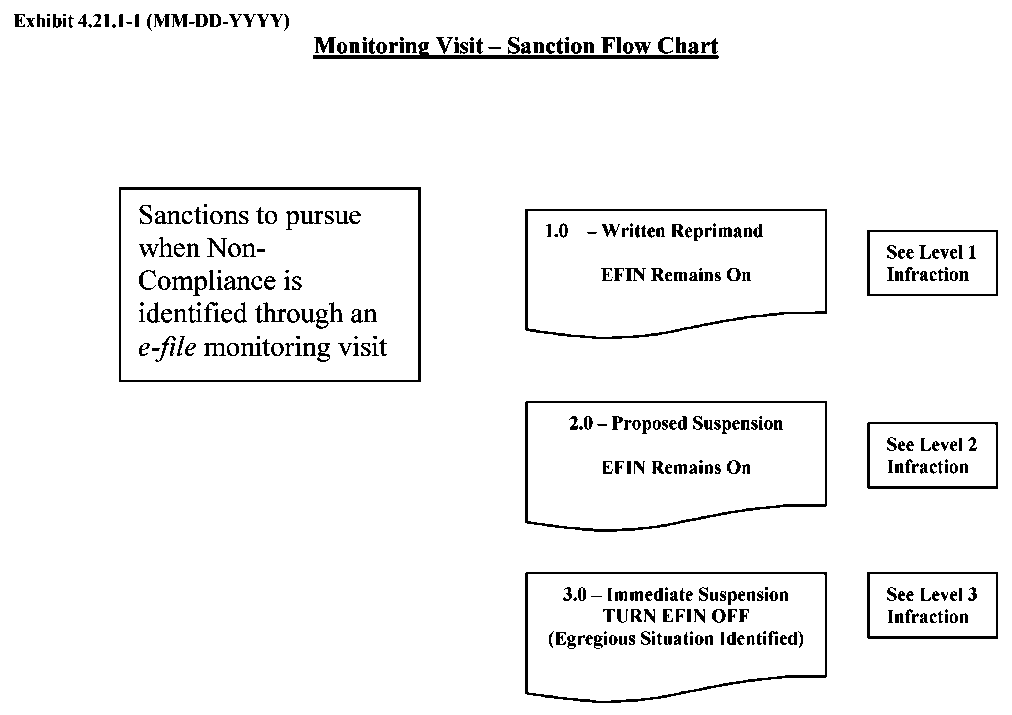
Please click here for the text description of the image.
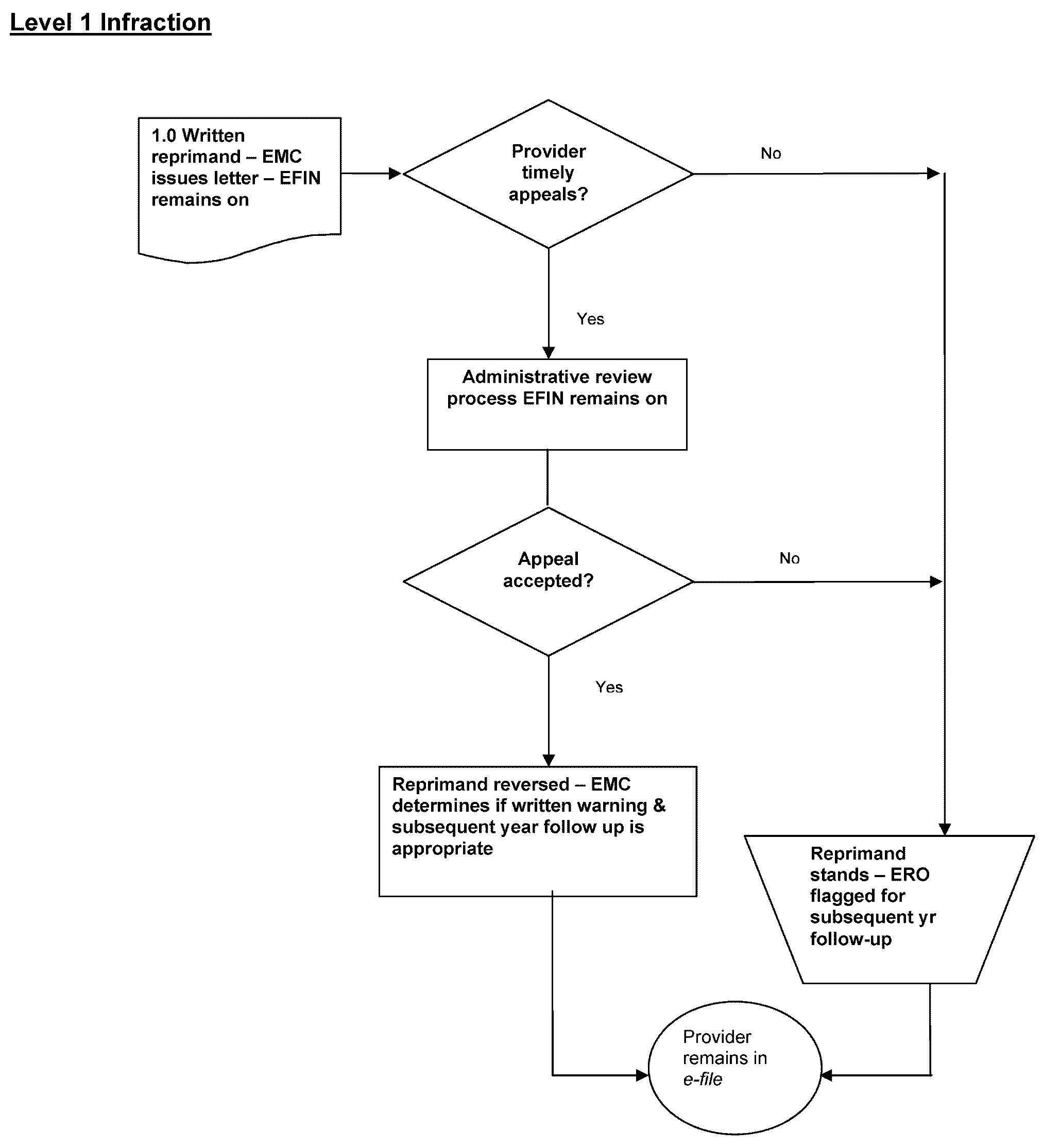
Please click here for the text description of the image.
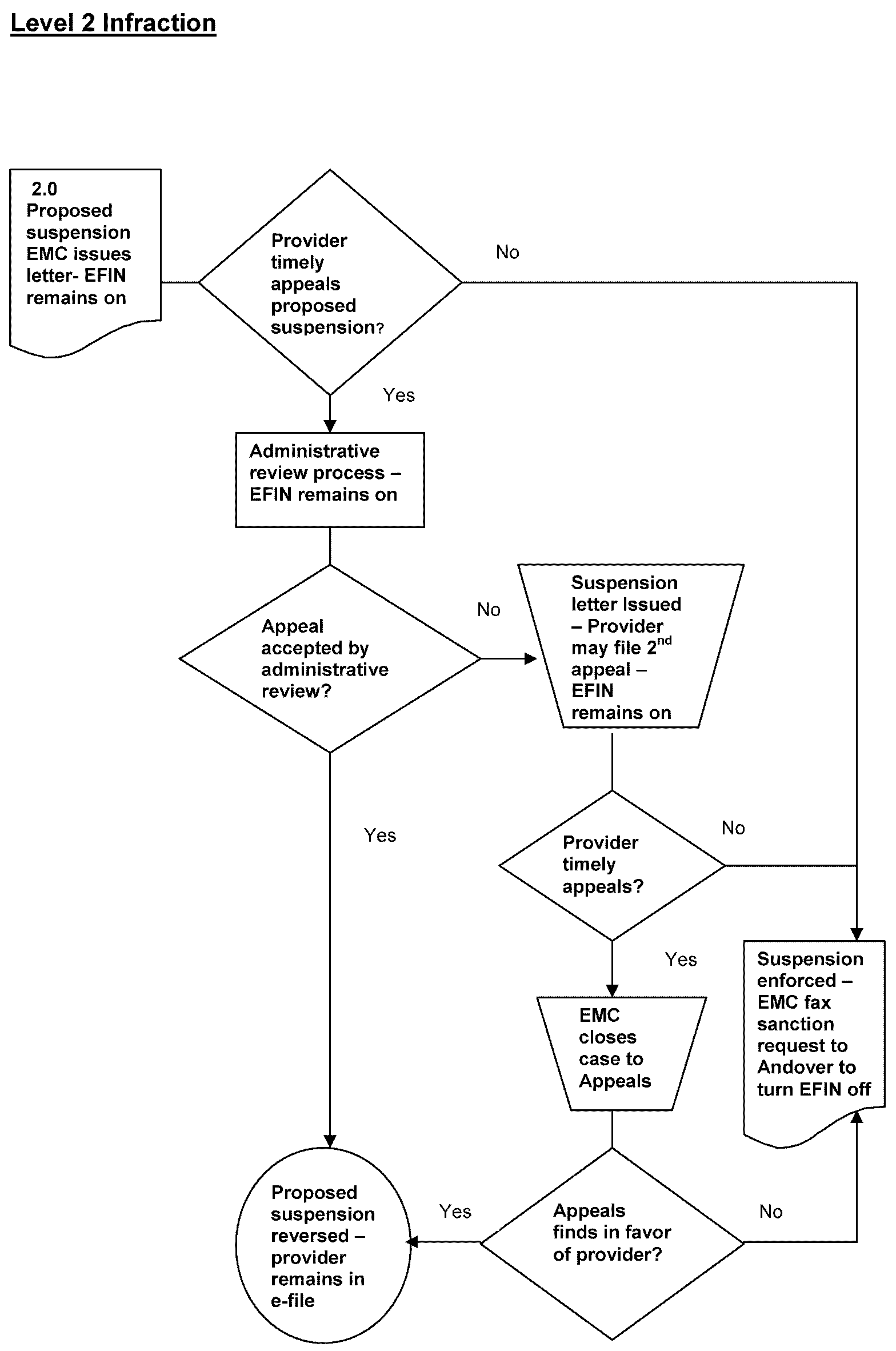
Please click here for the text description of the image.
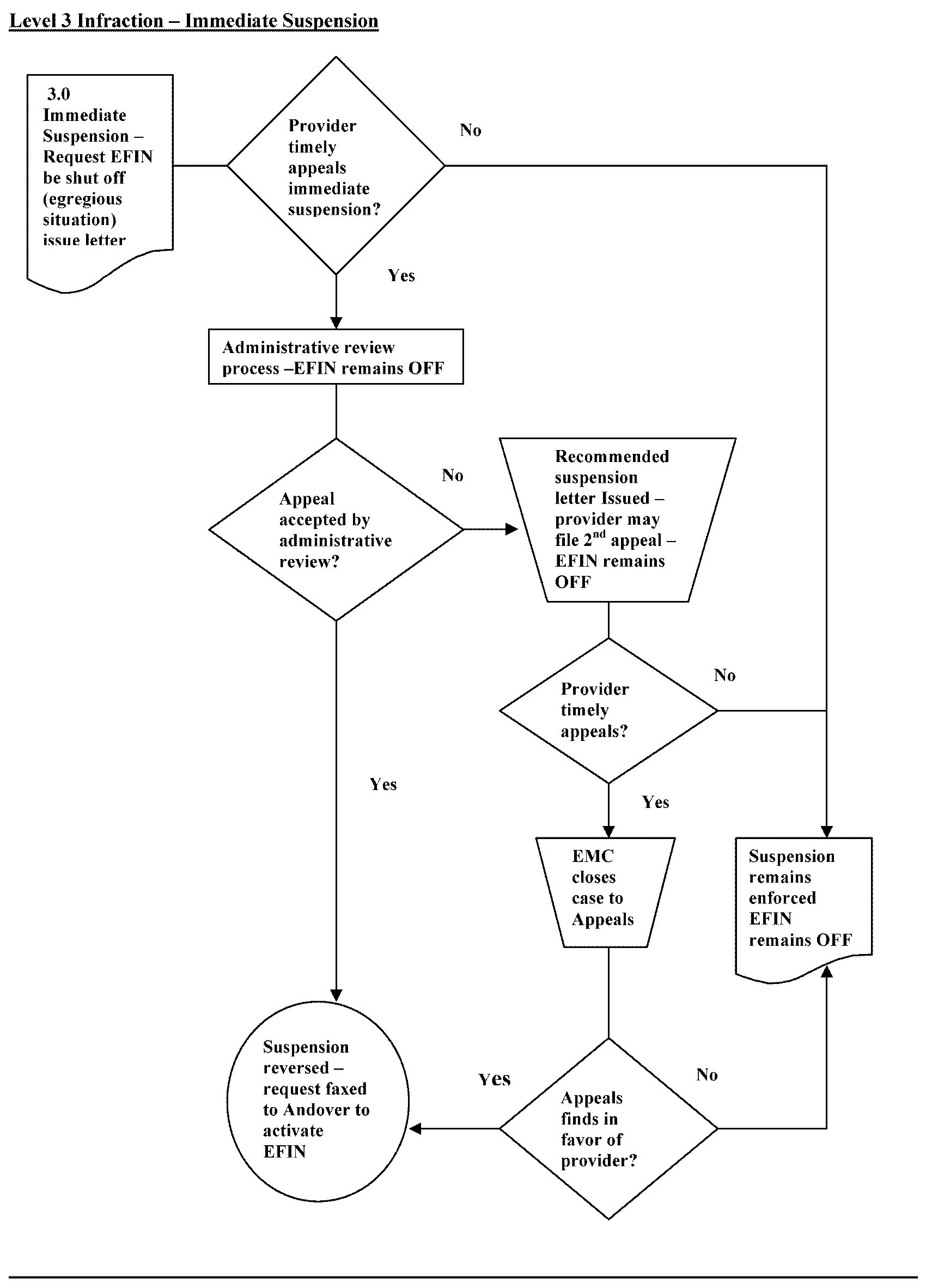
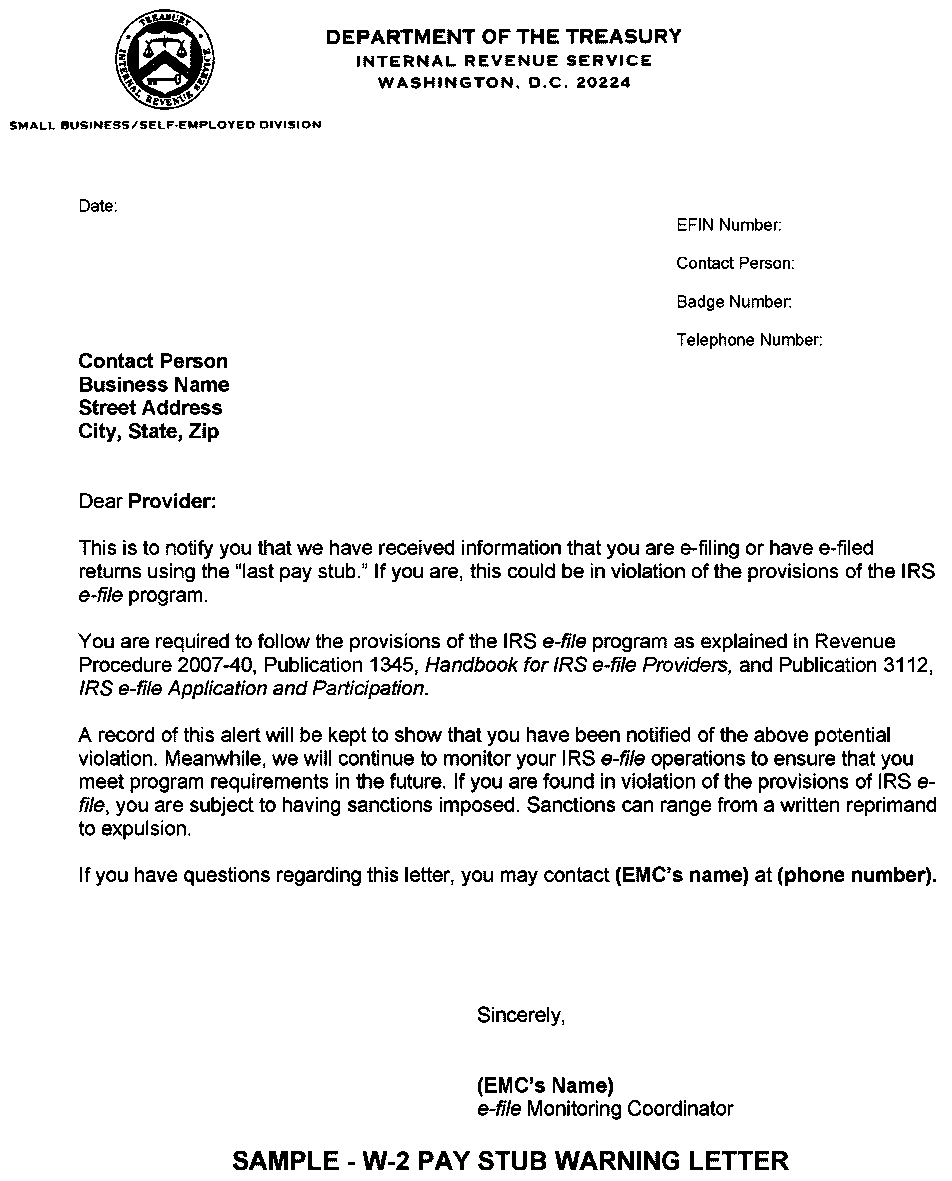
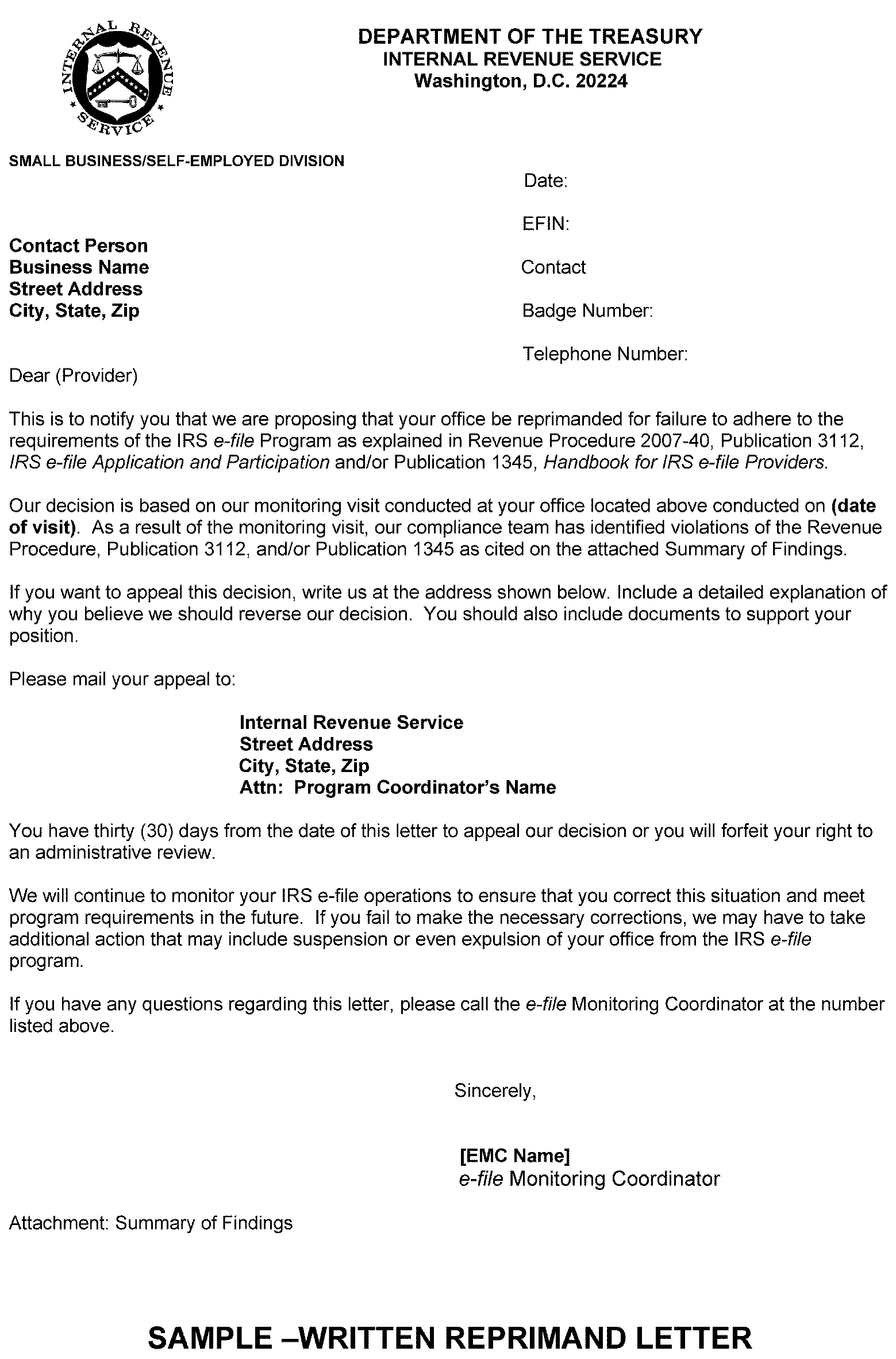
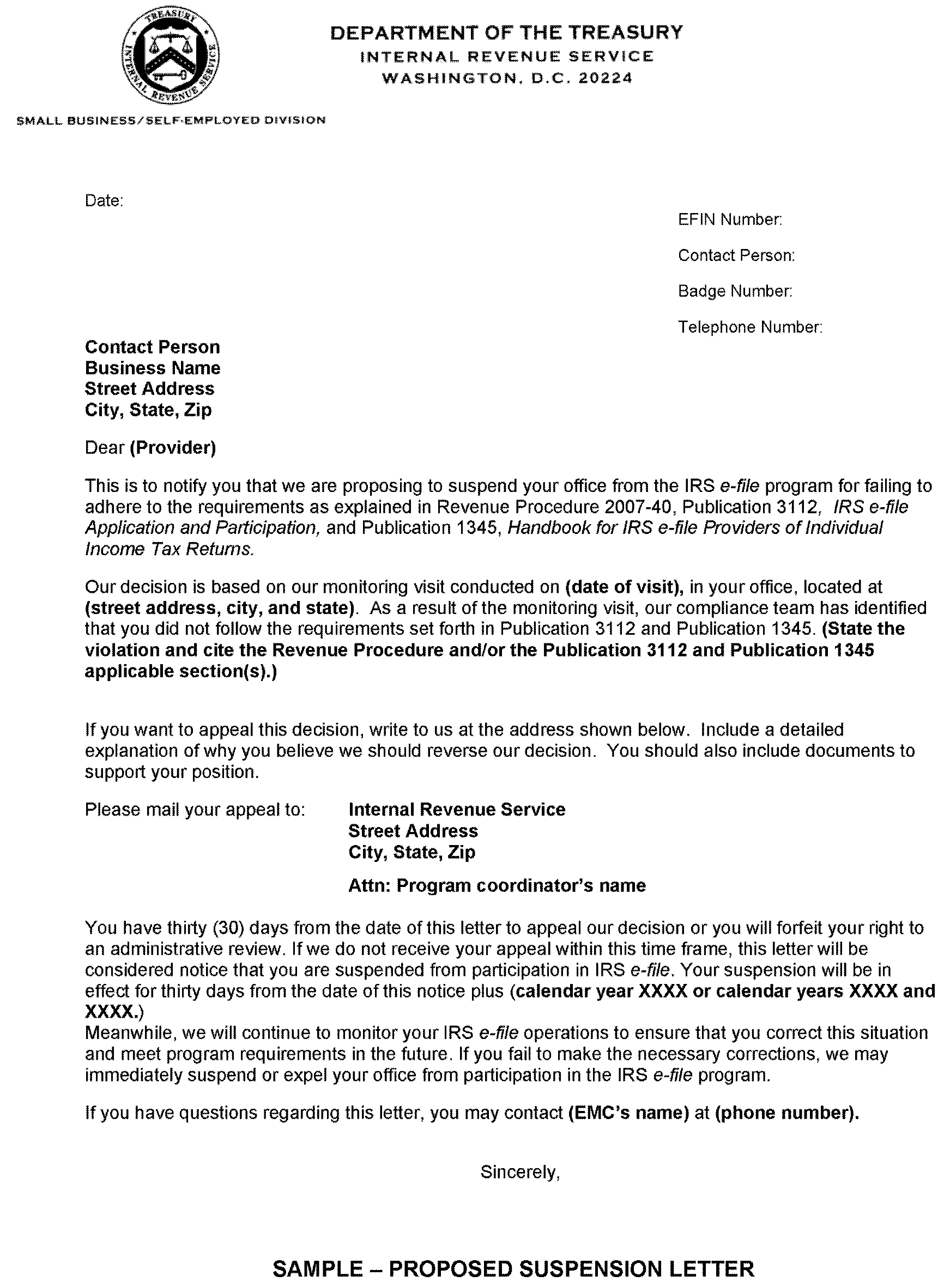
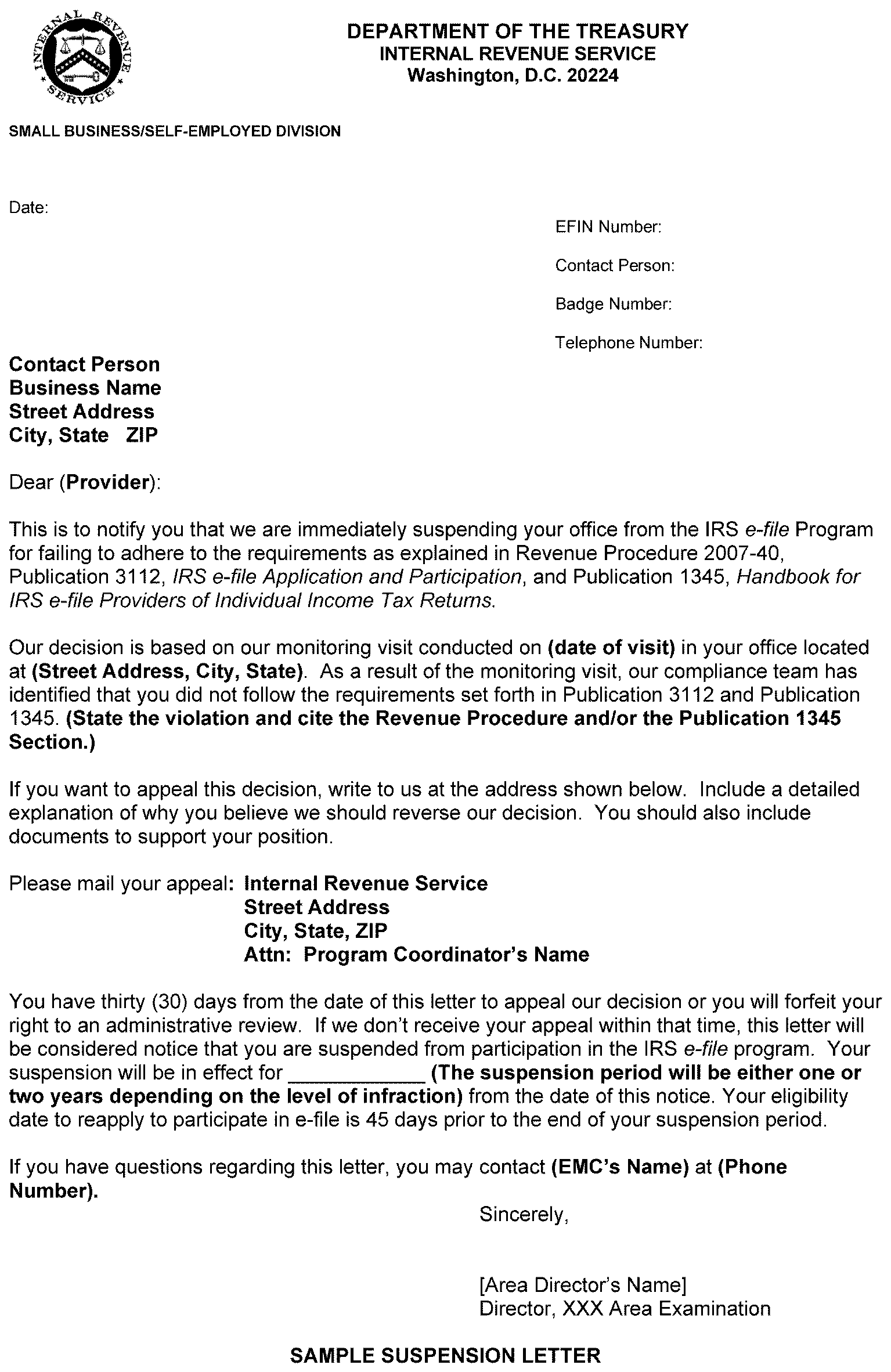
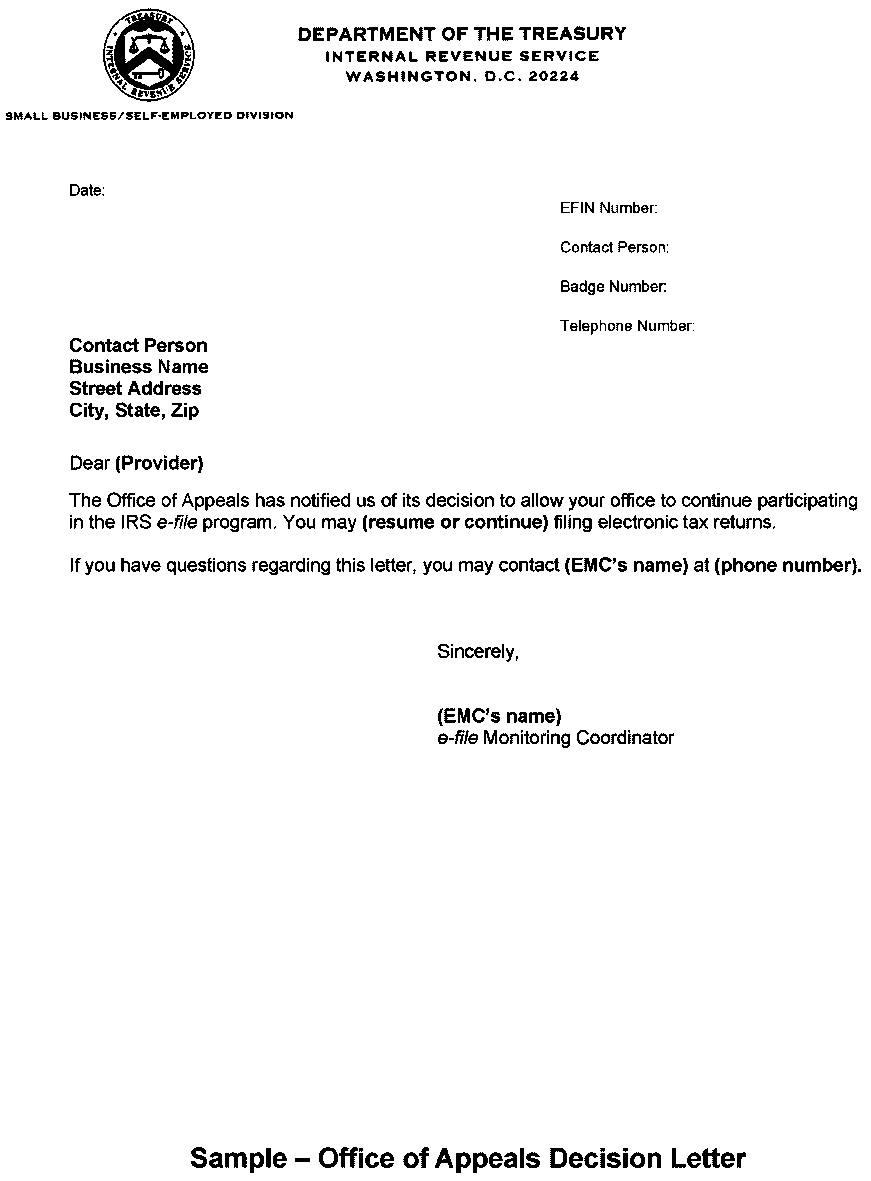
Please click here for the text description of the image.

Please click here for the text description of the image.
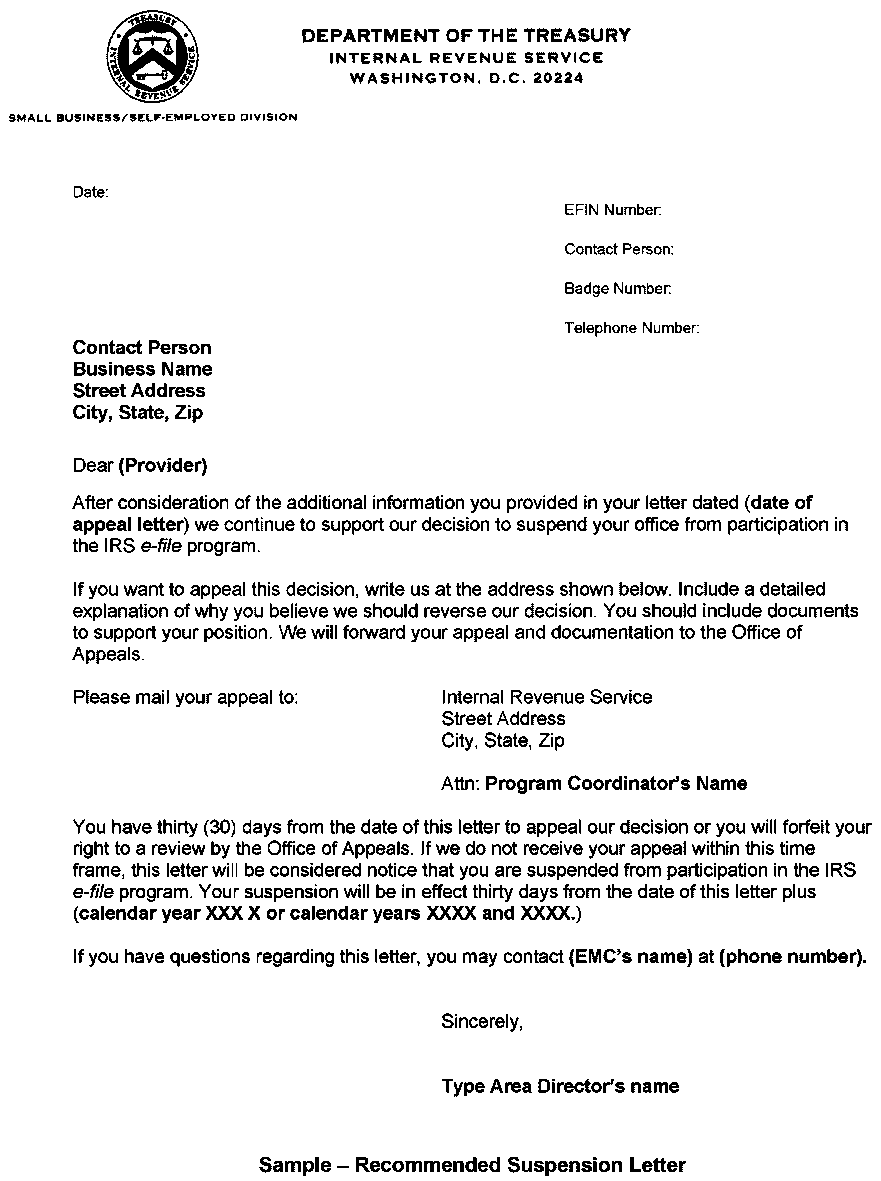
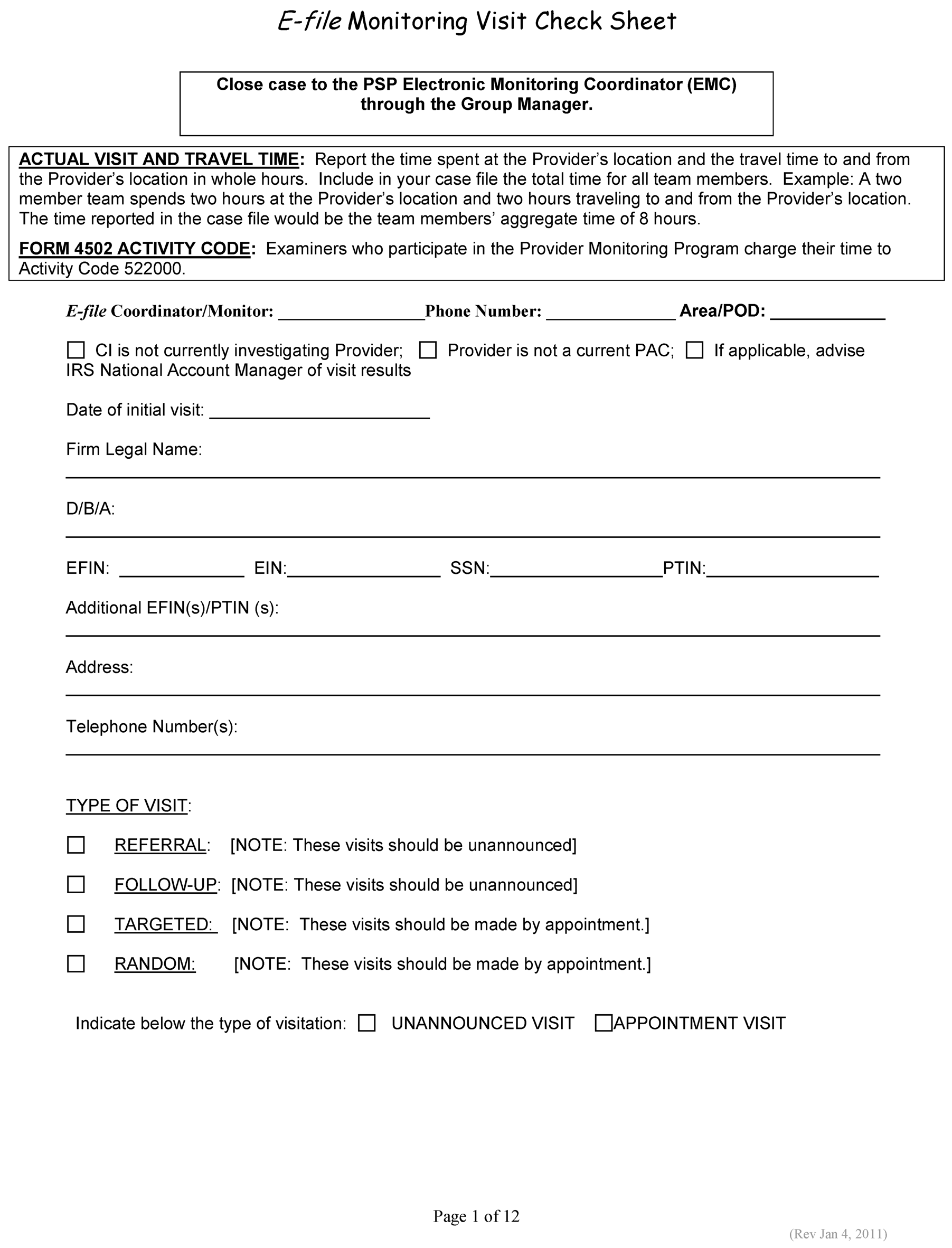
Please click here for the text description of the image.
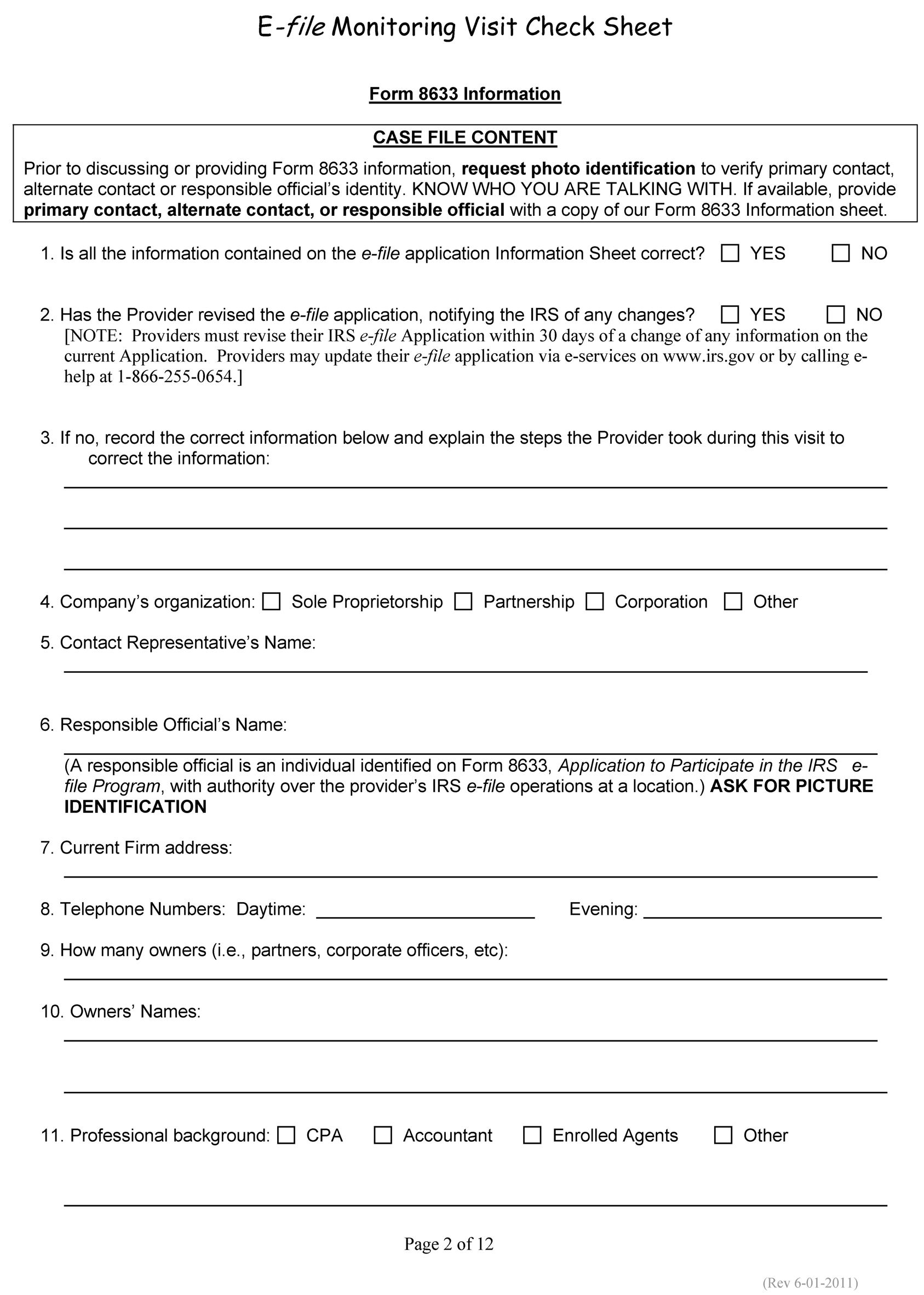
Please click here for the text description of the image.
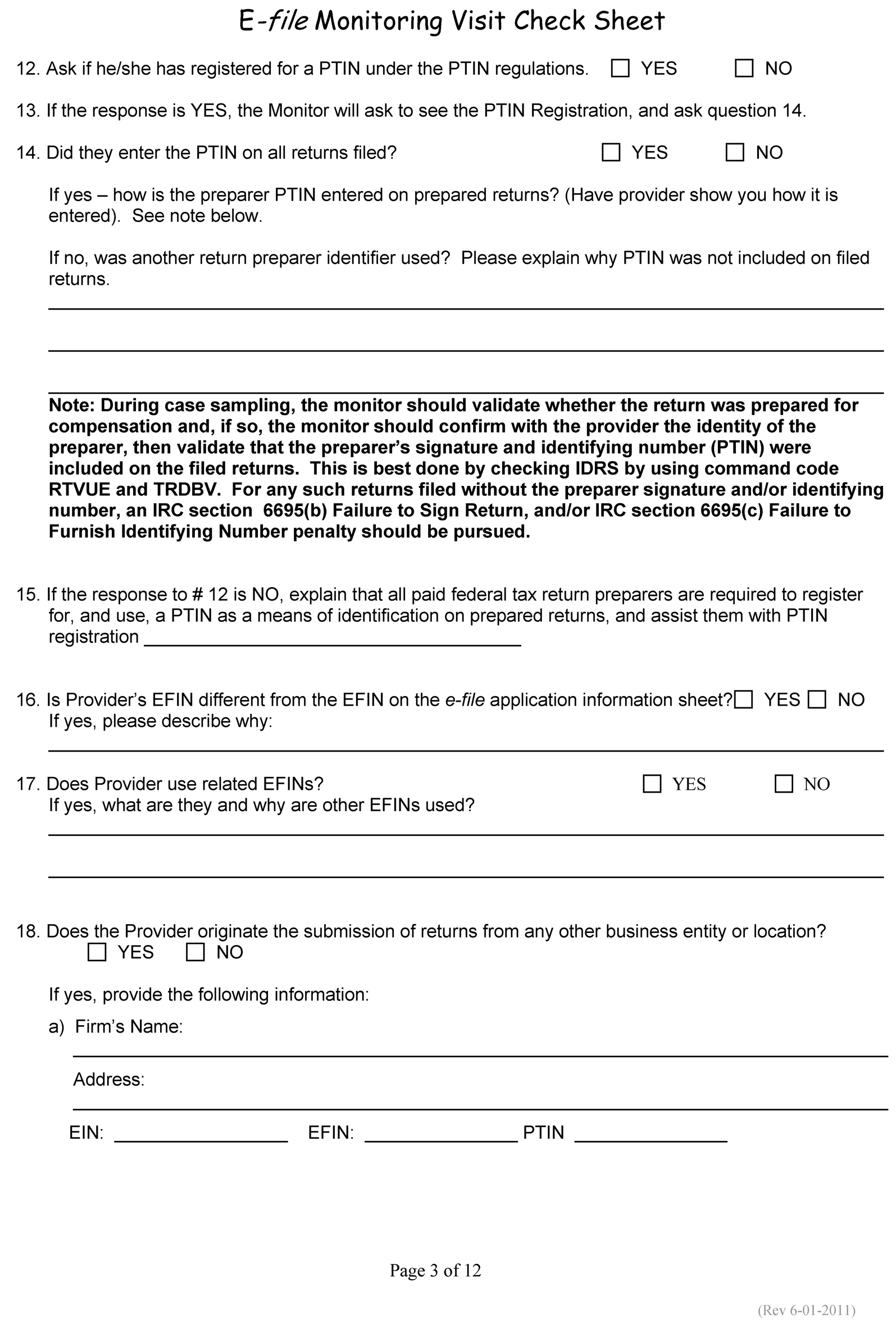
Please click here for the text description of the image.
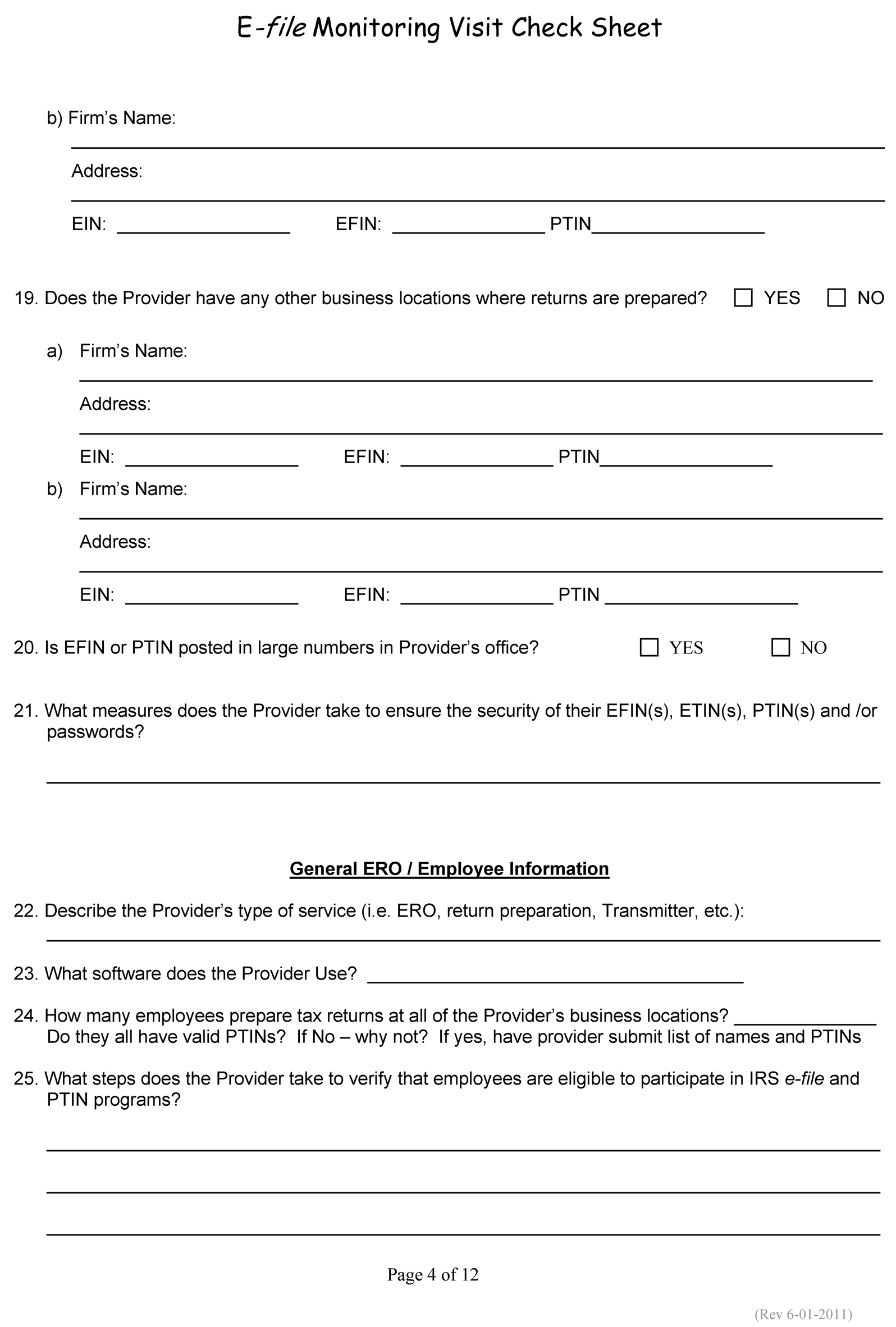
Please click here for the text description of the image.
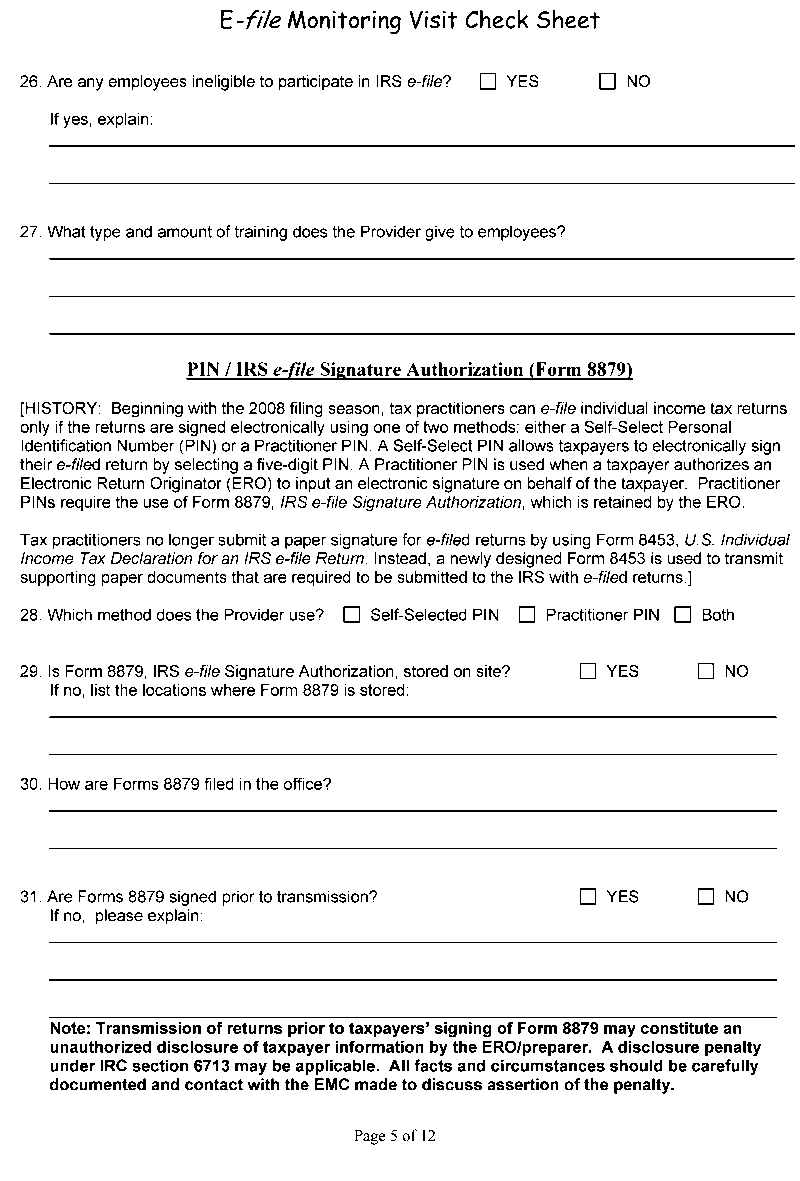
Please click here for the text description of the image.
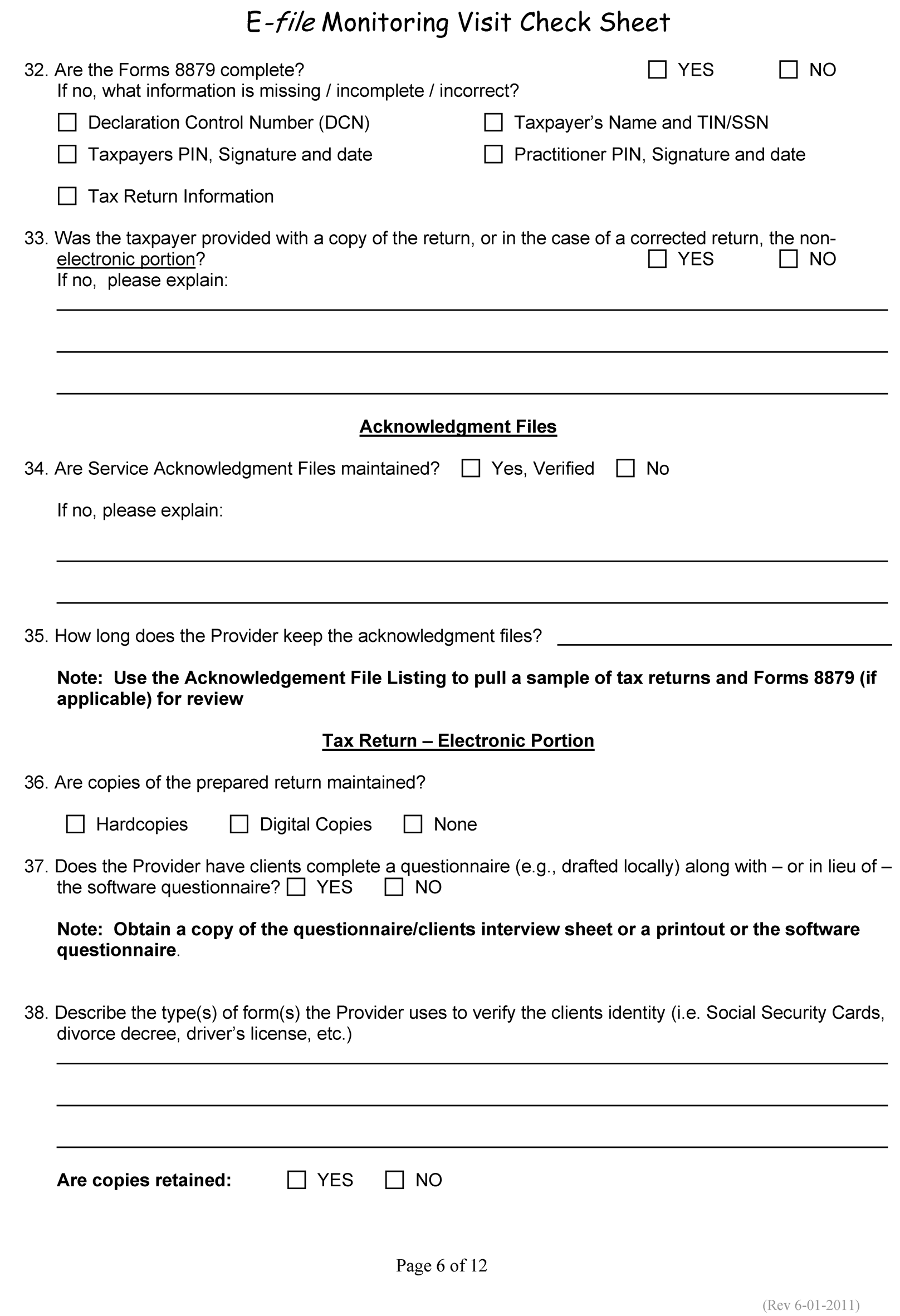
Please click here for the text description of the image.
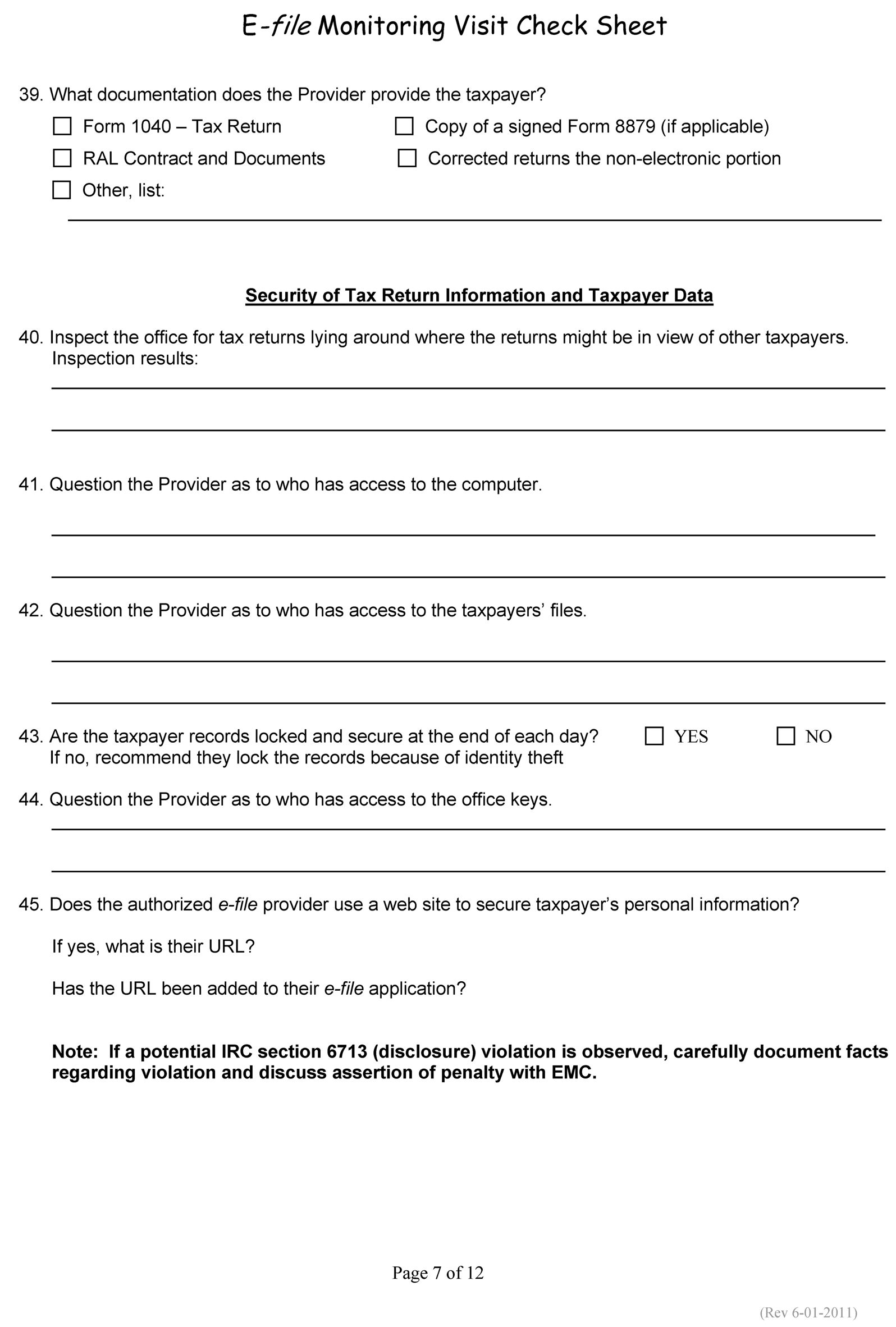
Please click here for the text description of the image.
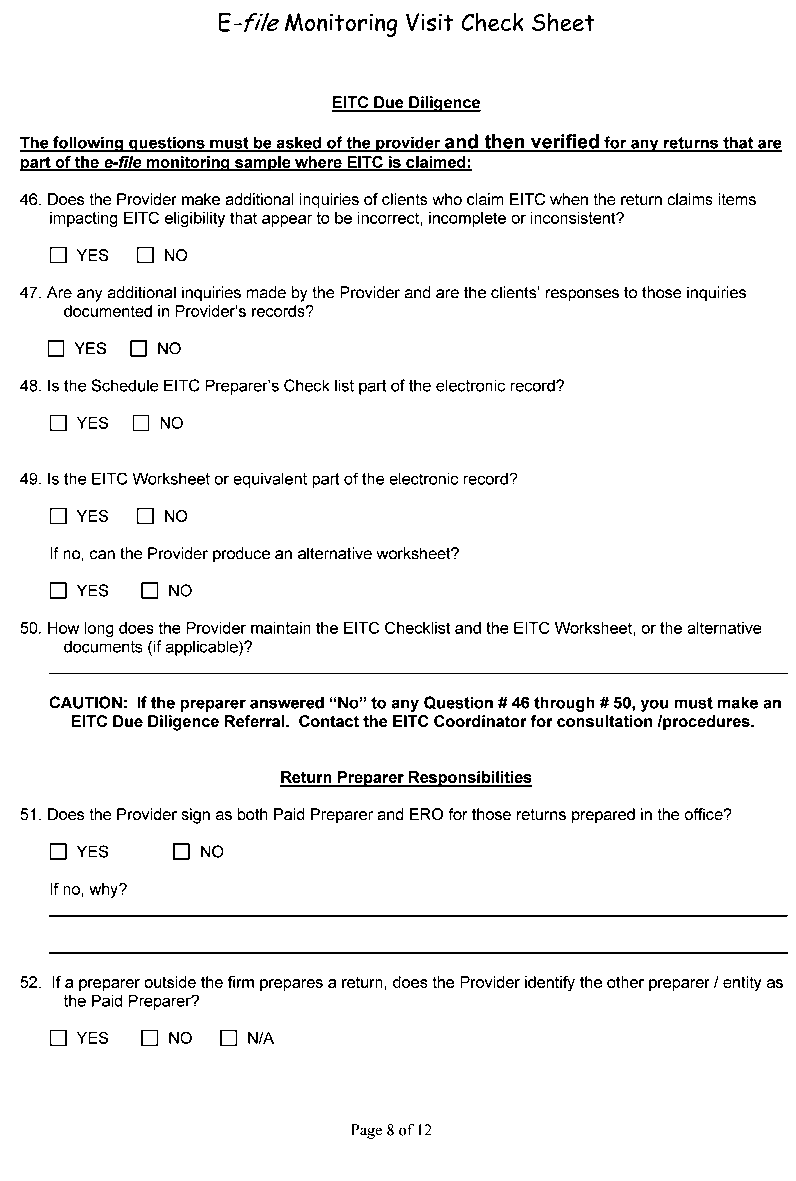
Please click here for the text description of the image.
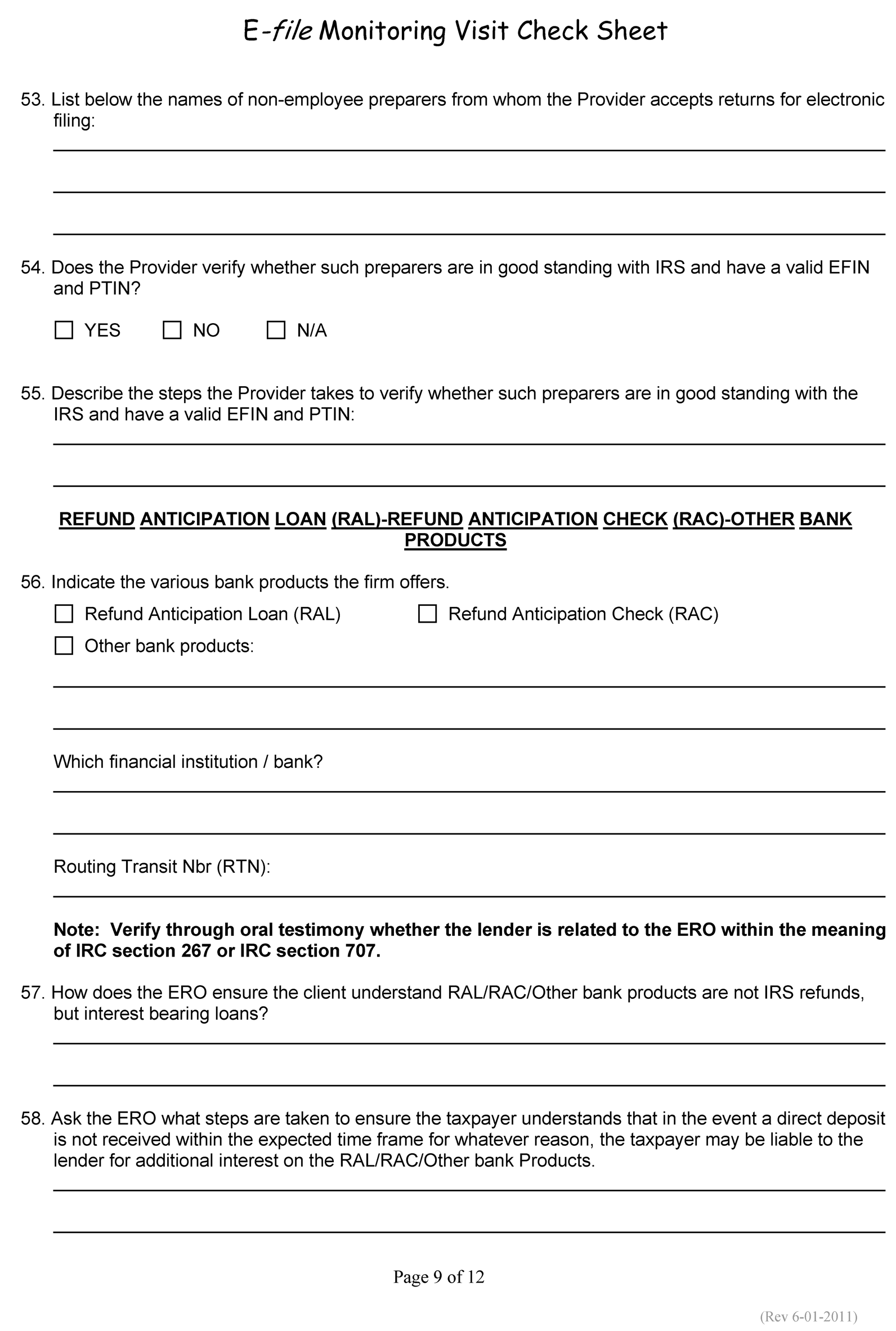
Please click here for the text description of the image.
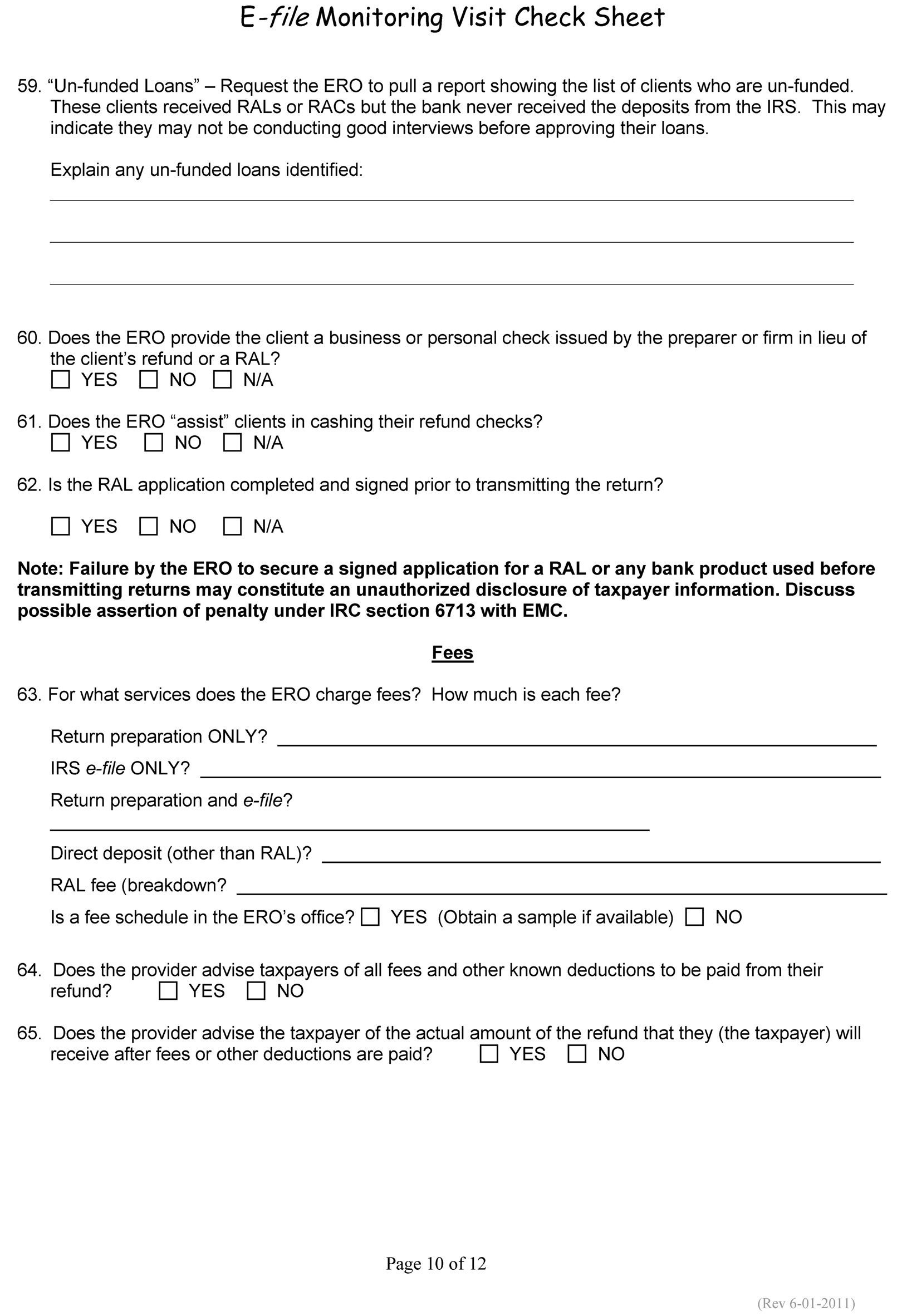
Please click here for the text description of the image.
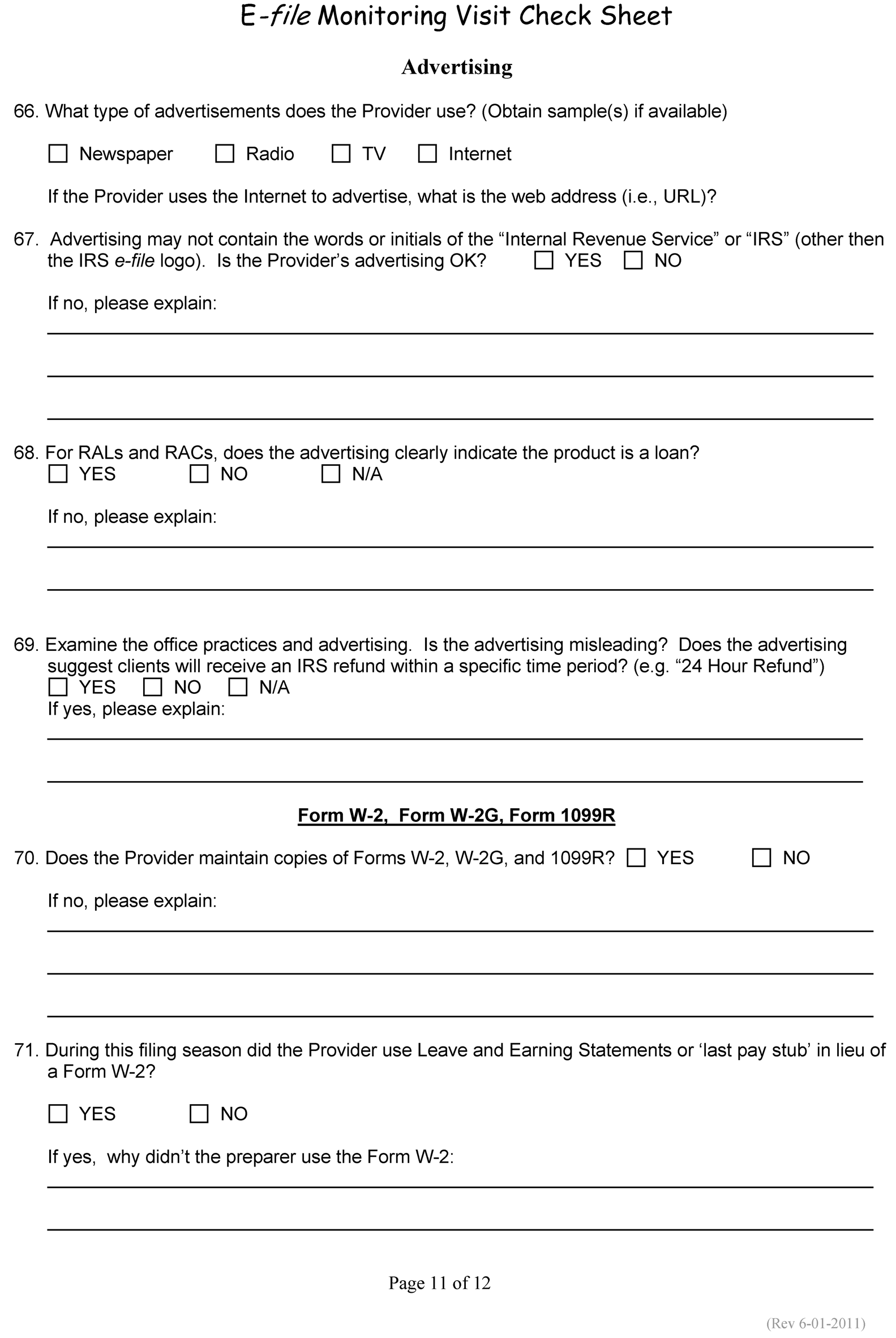
Please click here for the text description of the image.

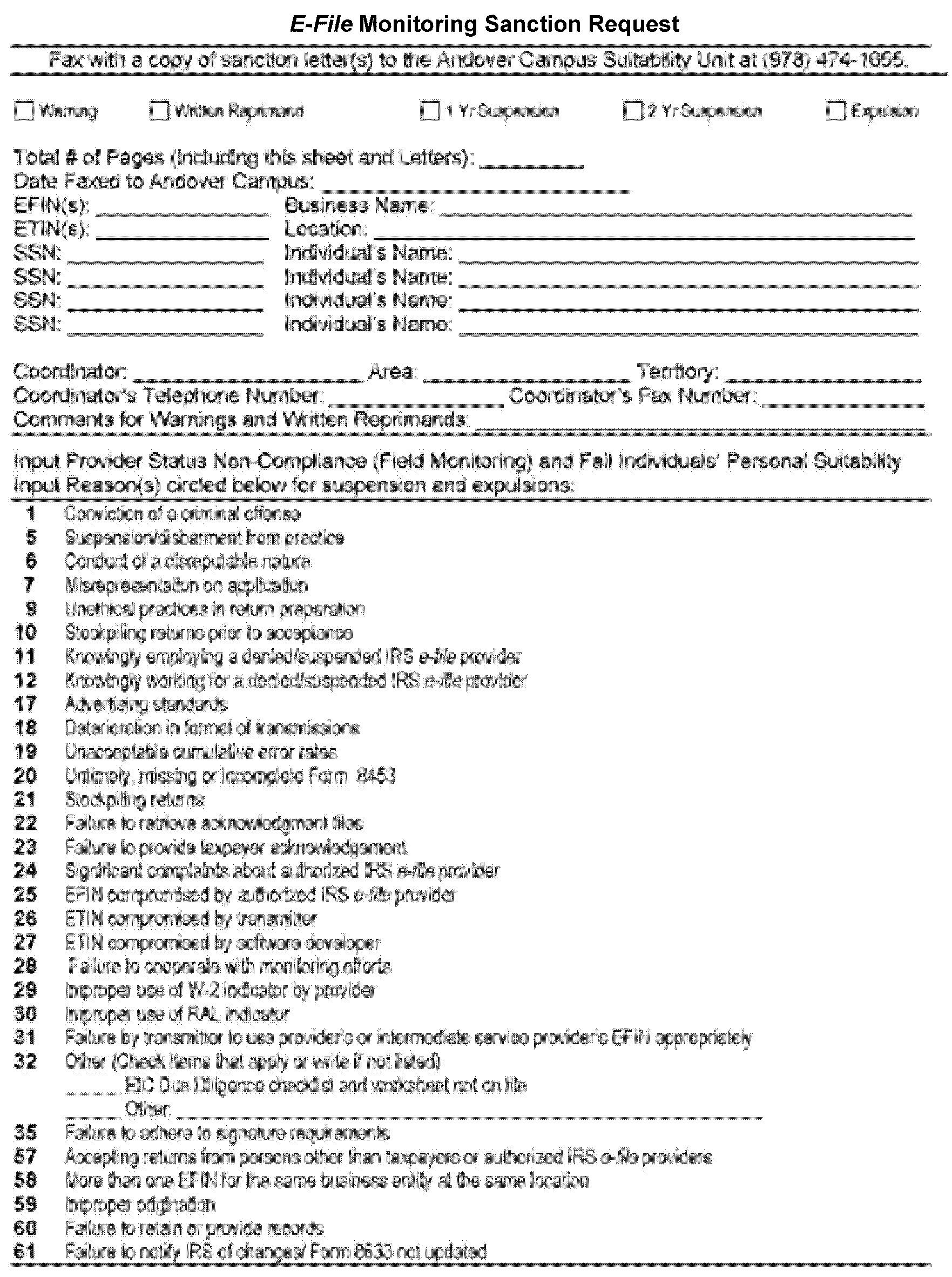
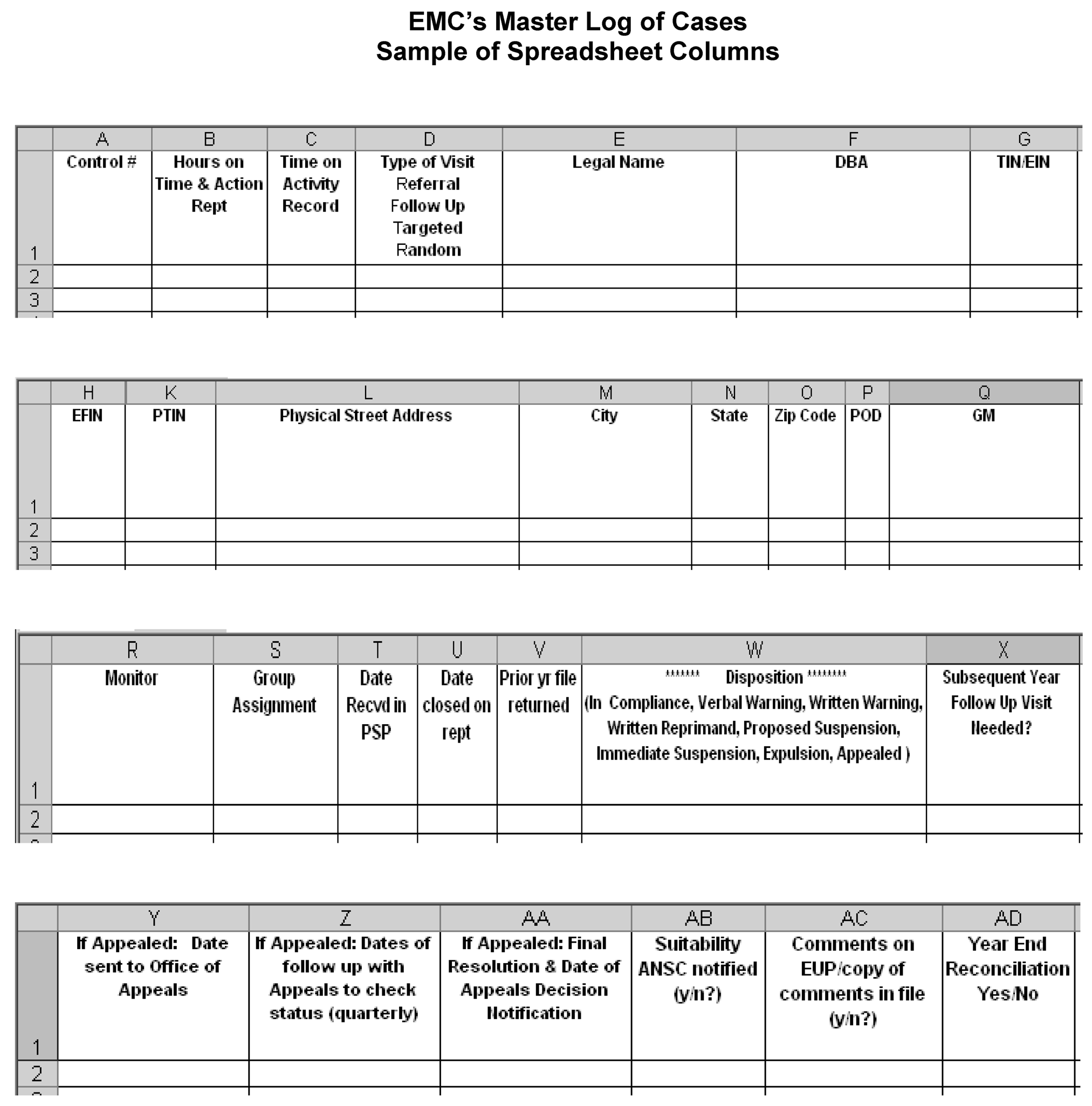
| Area Count Number | Control Number | Date Faxed to Andover | Firm Name and D/B/A and Address | EFIN | Date EFIN Suspended (Check TPDS) | Is Copy of TPDS in Case File? Yes/No |
|---|---|---|---|---|---|---|
| 1 | - | - | - | - | - | - |
| 2 | - | - | - | - | - | - |
| 3 | - | - | - | - | - | - |
| 4 | - | - | - | - | - | - |
| 5 | - | - | - | - | - | - |
| 6 | - | - | - | - | - | - |
| 7 | - | - | - | - | - | - |
| 8 | - | - | - | - | - | - |
| 9 | - | - | - | - | - | - |
| 10 | - | - | - | - | - | - |
| 11 | - | - | - | - | - | - |
| 12 | - | - | - | - | - | - |
| 13 | - | - | - | - | - | - |
| 14 | - | - | - | - | - | - |
| 15 | - | - | - | - | - | - |
| 16 | - | - | - | - | - | - |
| 17 | - | - | - | - | - | |
| 18 | - | - | - | - | - | - |
| 19 | - | - | - | - | - | - |
| 20 | - | - | - | - | - | - |
Control numbers are to be assigned to each case file regardless of whether a visit was made or not. Control numbers will be sequential beginning with 001. First 3 digits define the area, second 2 digits define the calendar year, and the last 3 digits are the sequential numbering of cases. Examples are as follows:
-
Southwest - 20707000
-
Central - 20207000
-
Gulf States 20507000
-
Midwest - 20407000
-
North Atlantic - 20107000
-
South Atlantic - 20307000
-
Western - 20607000
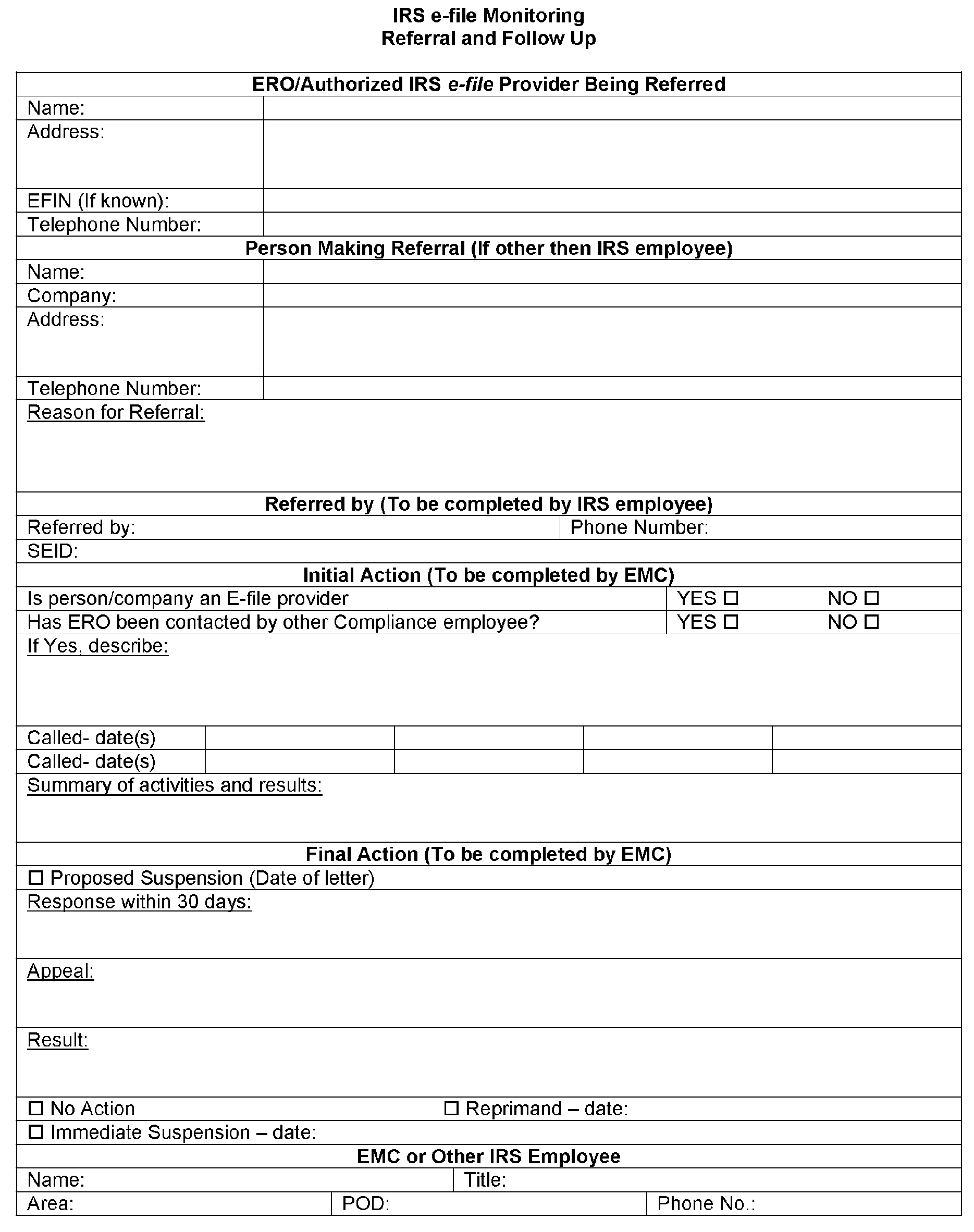
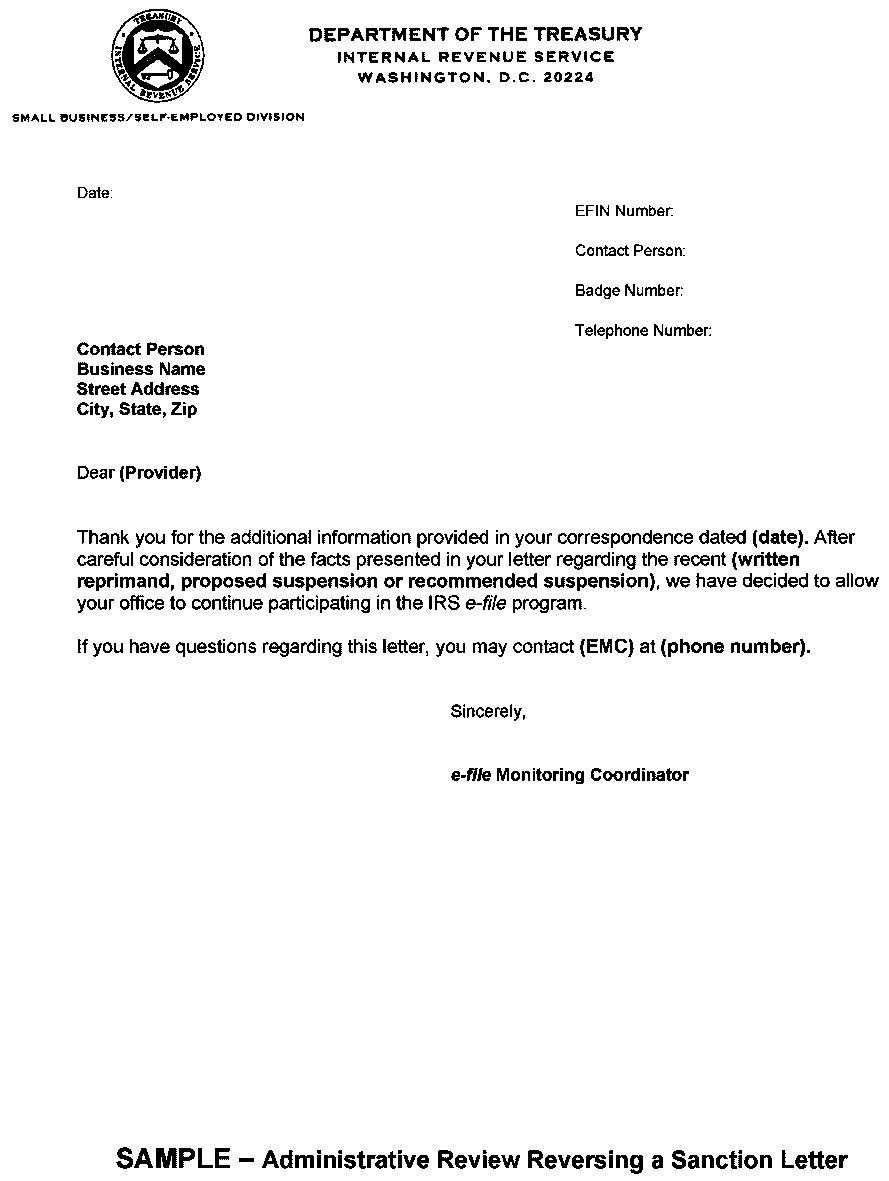
E-file Monitoring Report Instructions.
-
The first e-file monitoring report is due to the Exam HQ e-file analyst on the final Wednesday in January covering activity through the previous Friday.
-
The monitoring reports are due to the Exam HQ e-file analyst the Wednesday following the close of the reporting week. If you are going to be out of the office, please submit the report early.
-
Do not fill in any blue cells in the Excel spreadsheet because these cells contain formulas. Complete your area’s weekly report, using the spreadsheet provided, and send it to the Exam HQ e-file analyst.
-
A visit is counted as completed and included on the report when the e-file Monitoring Coordinator (EMC) receives the case file from the monitor for closure. If the e-file monitor went to the business location but was unable to perform a compliance visit because it is closed/no longer there, this should not be counted as a visit.
-
If a follow-up visit is required and you have counted the visit once, do not count it again.
-
Letters and phone calls to the providers are reported, but they are not counted as visits.
Sample e-file Monitoring Report below:
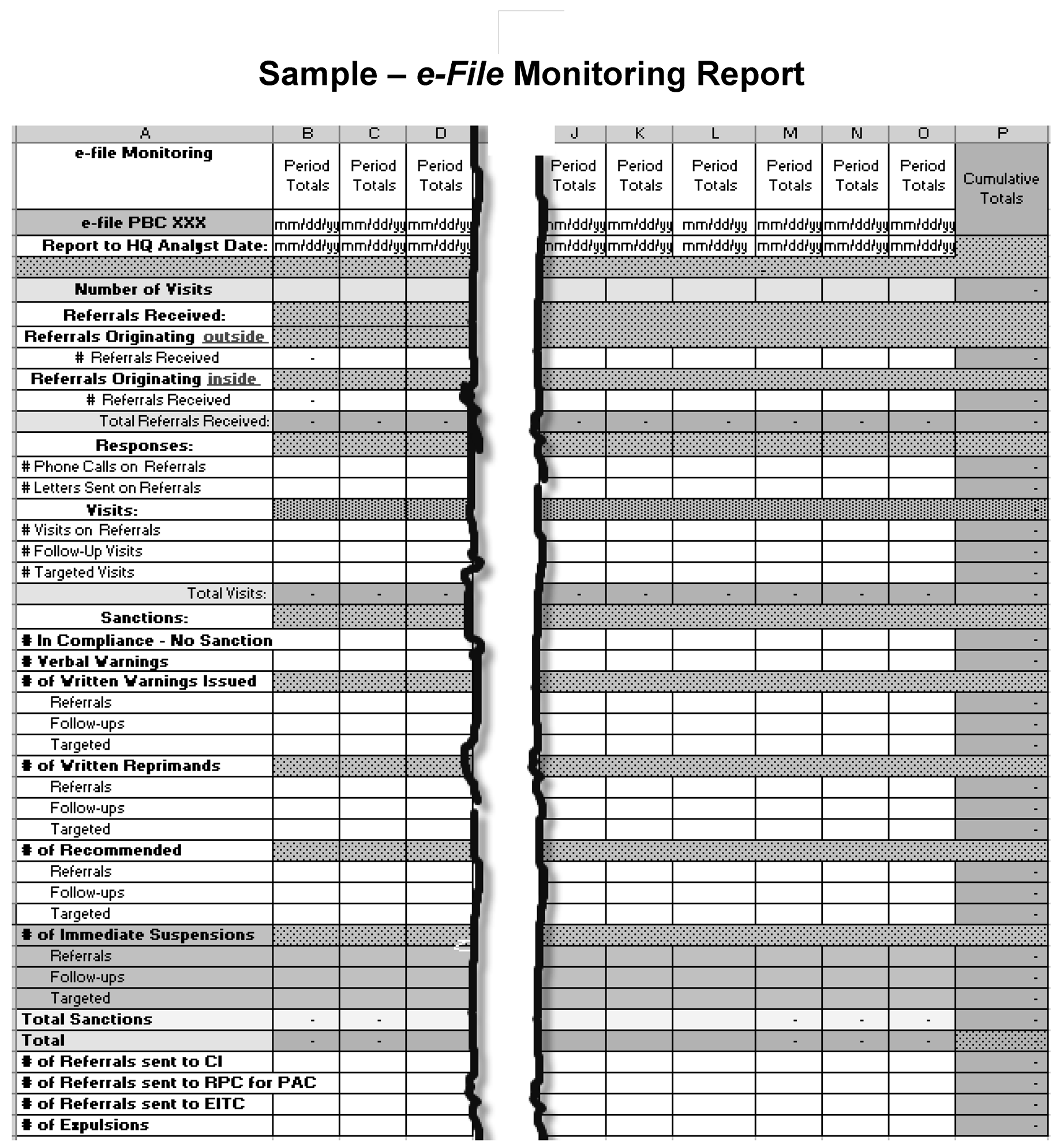
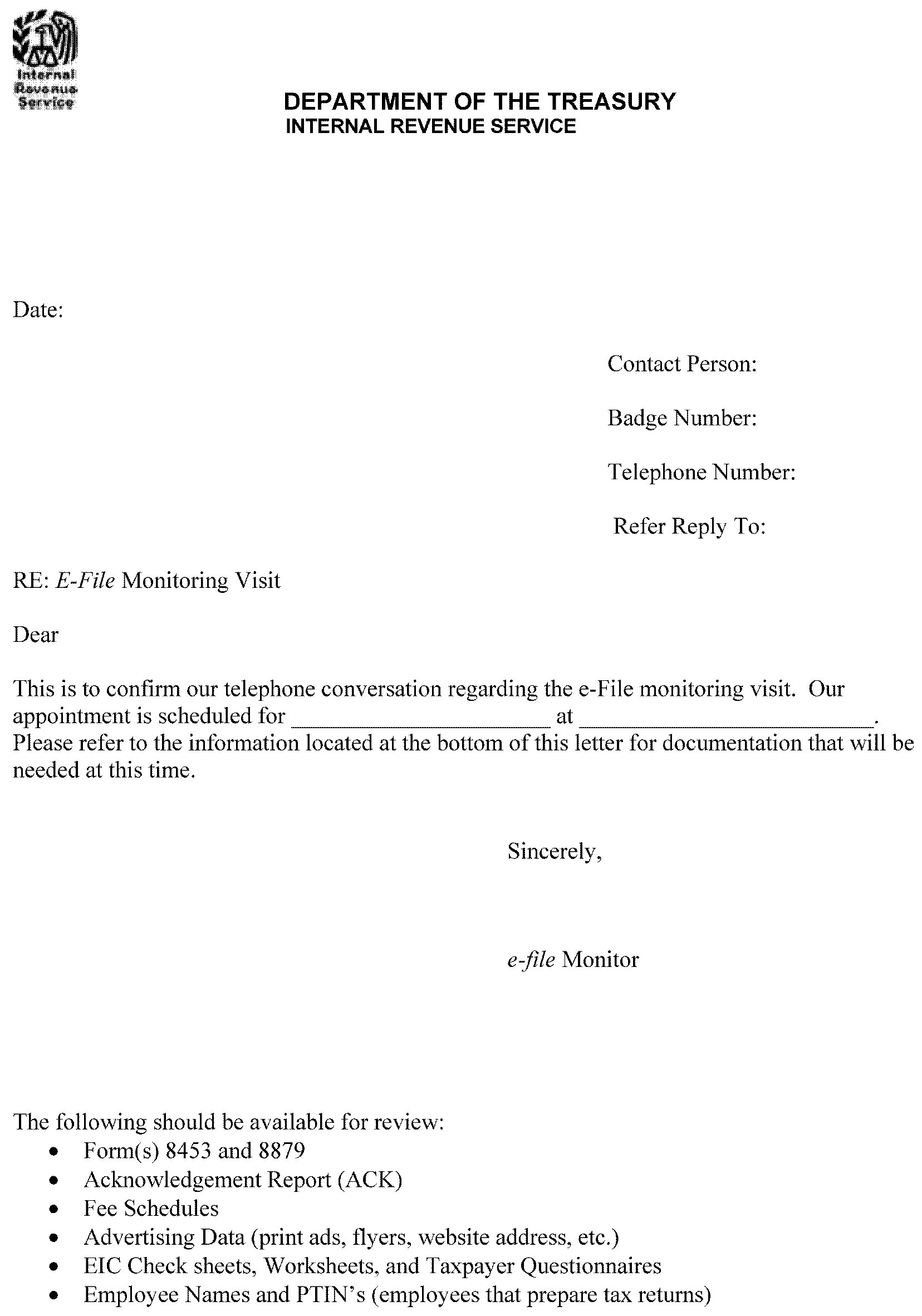
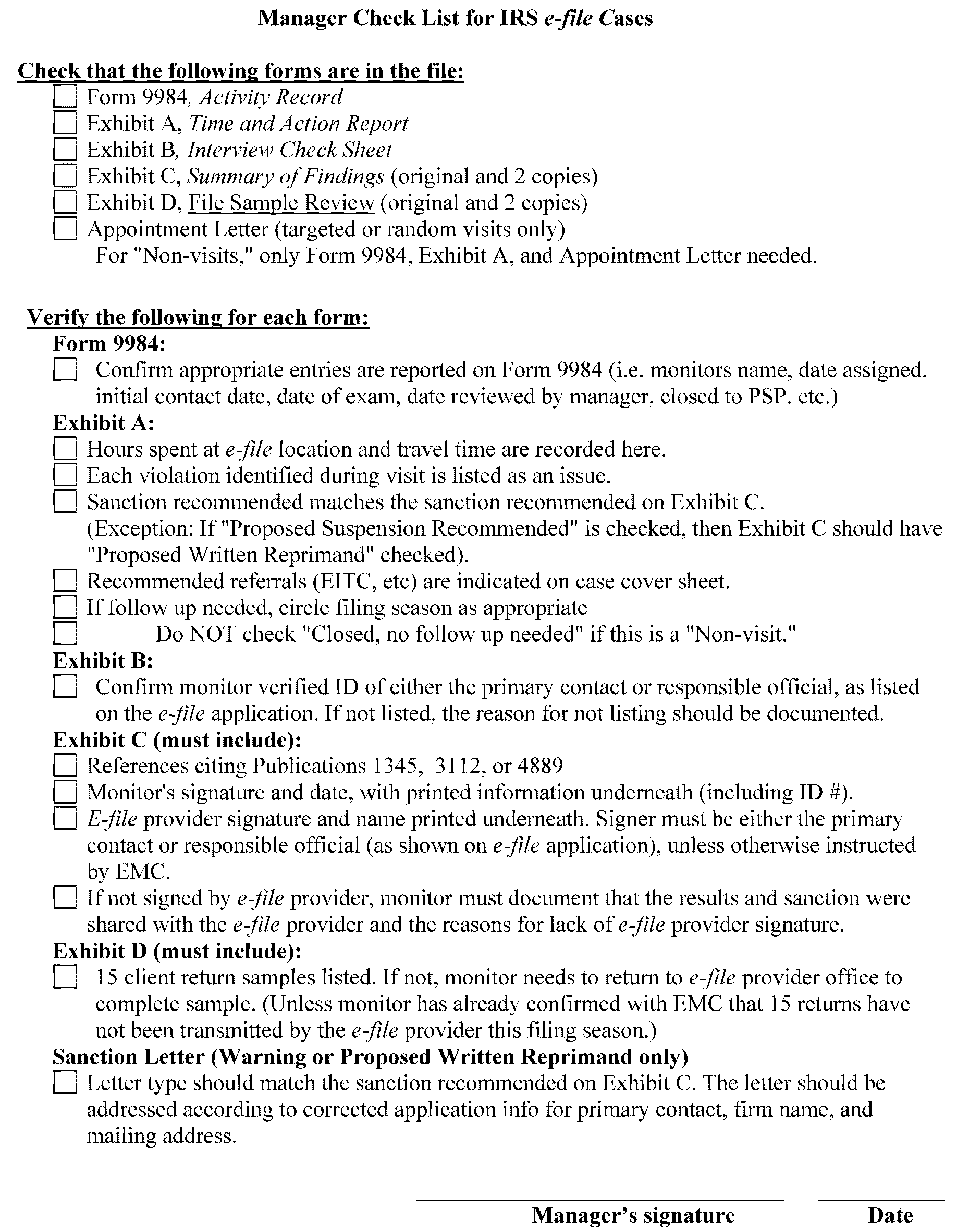
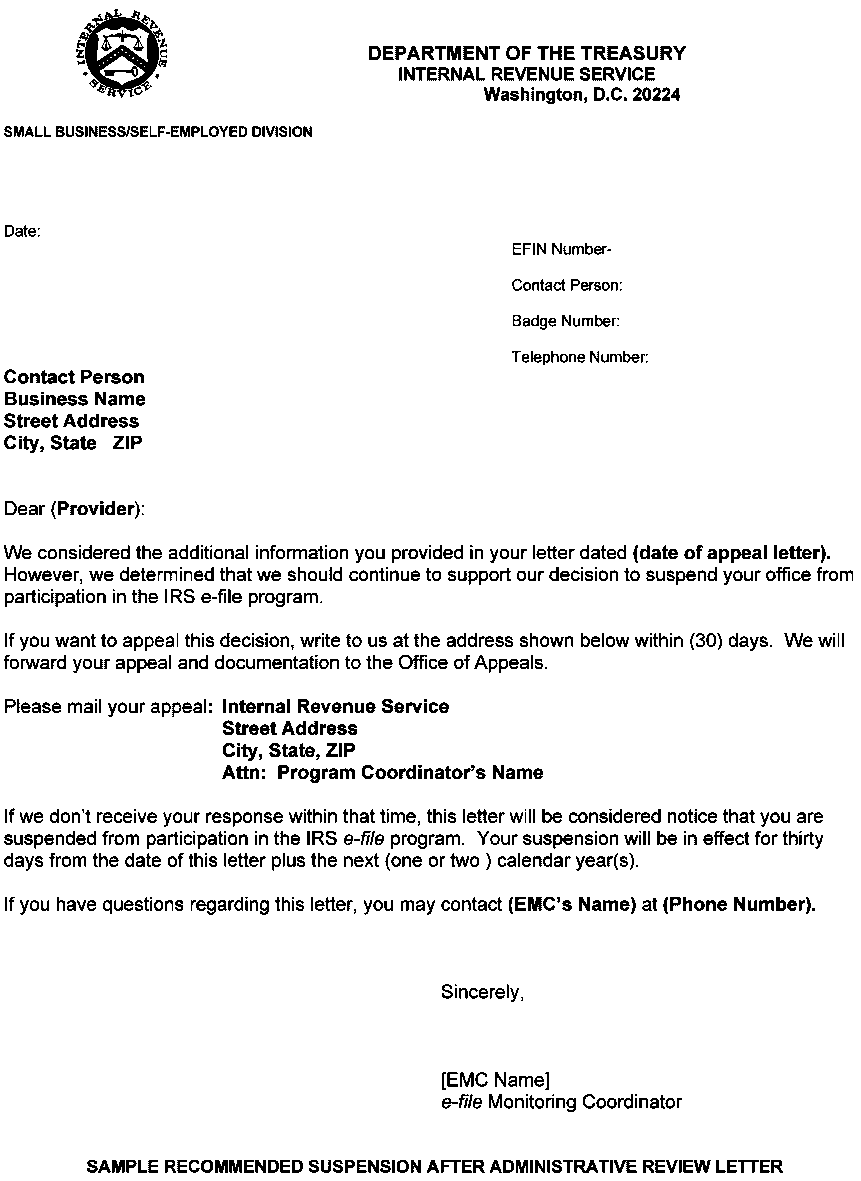

 )
或 https:// 表示您已安全连接到 .gov 网站。仅在官方、安全的网站上共享敏感信息。
)
或 https:// 表示您已安全连接到 .gov 网站。仅在官方、安全的网站上共享敏感信息。



